How to Write a Customer Service Resume Objective with Examples
Quick Navigation:

Why is a strong customer service resume objective important?
How to write a customer service resume objective, examples of well-written resume objectives for customer service, examples of customer service resume objectives that are not well-written.
Customer service jobs can be competitive, and dozens of people may send in applications for the same position. A strong resume objective that shows an employer how useful you can be to the company can help you distinguish yourself from applicants who are responding to the same customer service position.
Generally, you should include your relevant qualifications, skills, experience and most notable past successes in your resume objective. Be sure to condense all the relevant information into an attention-grabbing statement. A good customer service objective should be no more than two or three sentences. This way, the employer can quickly and easily see how you’re qualified for the job.
You can create your resume objective for a customer service position by following these steps:
1. First, consider your qualifications
Take inventory of your prior experience, skills, qualifications and expertise, and include the most impressive accomplishments in your objective.
2. Second, use numbers to showcase your past achievements
Include quantifiable data and metrics that demonstrate the impact you had in past positions, such as the number of new accounts you opened, the volume of business you generated or the customer retention rate you helped your previous company achieve.
3. Next, highlight relevant skills
Indicate desirable skills or qualifications that show your usefulness to the company. Choose relevant skills such as communication, teamwork and time management.
4. Lastly, explain your experience
It can help to state how many years of work experience you have in customer service, especially if you’re looking for a leadership position.
Here are some examples of effective resume summaries that you can use as a guideline when writing your own:
‘Secure a job as a customer service representative with Seven Seas Company, which will enable me to use my communication skills and interpersonal skills to serve customers. Good problem solver, able to multitask and consistently finishes projects before their deadlines.’
‘Obtain a job as a customer representative where I can use my exceptional interpersonal and communication skills to resolve customer issues and foster a positive relationship between the customers and the company.’
‘Diligent and personable customer service representative seeking a position in which my communication skills combined with my problem-solving skills can be useful in serving customers. Capable of handling multiple tasks in a fast-paced environment. Able to keep customers happy and smiling while resolving their issues in the shortest time possible.’
‘Experienced customer care professional with three years of experience in the telecommunications industry. Now seeking a challenging but rewarding role in a position where I can use my interpersonal skills to provide the highest level of support to customers of DataSecure, LLC.’
‘Seeking a customer service position with NextGen Corporation to use my excellent customer service experience and people-oriented skills to enhance customer loyalty and deepen client relationships.’
Example 6
‘Customer service representative with five years’ experience providing excellent services to customers in a dynamic work environment. Solid communication skills, good interpersonal skills and fast in resolving customer complaints with excellent problem-solving skills.’
‘Confident and energetic customer service representative passionate about serving customers. Thrives in a challenging and fast-paced environment. Able to interact freely with customers and resolve issues quickly. Now looking for a rewarding position where I can serve customers and increase customer retention.’
‘Self-driven customer service professional with over 10 years of experience working in a dynamic call center. Strong verbal and written communication skills. Passionate about building lasting relationships with customers.’
‘Experienced customer service coordinator with strong leadership skills. Able to design, implement and maintain cost-effective shift schedules for Telkom’s call center of more than 200 customer representatives. Efficient in managing and tracking client’s attendance records. Results-oriented professional who’s able to ensure customer representatives deliver an outstanding experience.’
‘Detail-oriented professional with over four years of experience in a busy customer-service environment. Proven ability to handle customer issues quickly and discreetly while nurturing positive relationships and increasing customer retention rates by 54%. Seeking to leverage these skills as a reliable customer service representative.’
Example 11
‘Customer service representative with three years of experience in a busy IT help desk. Holds a bachelor’s degree in IT. Seeking to use my diagnostic skills and troubleshooting skills to help customers resolve a range of computer and networking problems.’
‘Seeking a customer service representative position where I can use my experience and communication skills to handle customer complaints and queries and deepen the relationship with customers.’
Example 13
‘Qualified customer service professional with over 14 years of experience in customer care roles, including sales, tech support and customer care. Good listener, astute problem solver and confident on the phone. Proficient with various CRM tools. Seeking to use my customer service skills to provide a positive experience to the customers in your firm.’
‘Personable and articulate customer care professional with a history of providing outstanding support to customers. Able to maintain a positive attitude when serving customers in the banking hall. Possesses good judgment and the ability to handle confidential information discreetly. Seeking a customer service role within a financial institution that offers rewarding opportunities for dedicated people.’
‘Customer-centric professional with three years of experience serving customers in different roles. Proven ability in engaging customers, resolving complaints and strengthening customer-client relationships. Seeking a rewarding position with a company that values its customers.’
Here are some examples of poor resume objectives:
‘Seeking a position as a customer service representative in a fast-growing company.’
The above resume objective doesn’t indicate the applicant’s qualifications or skills, which gives the employer no way to know what value they would bring to the company.
‘To obtain a customer service position with a company, which will require me to use my skills for the company’s success.’
Not only is this objective vague and generic, but it also doesn’t highlight the applicant’s experience and skills. It also doesn’t state what value they bring to the company.
‘Secure any position that requires me to use my interpersonal skills and analytical mind to resolve customer issues and complaints.’
While this objective states how the applicant’s skills are of value, it doesn’t clearly state the position they’re applying for.
In general, a poorly-written resume objective leaves out relevant details, doesn’t state the position being applied for, or otherwise fails to show how the applicant’s skills will benefit the employer.

30 Top Customer Service Resume Objective Examples + Sample
Your resume objective is your first chance to make an impression on a hiring manager.
For customer service roles, your objective highlights your top skills and experience.
It shows how you can provide excellent service that improves customer satisfaction.
This article will provide 30 examples of effective customer service resume objectives.
We’ll also discuss how to write a strong objective tailored to your own background.
With these tips, you can craft an objective that will grab attention and land more interviews.
Read Also : How to Apply for a Schlumberger Internship
How to Write a Customer Service Resume Objective
Your objective sits at the top of your resume under the header with your name and contact information.
It is usually 3-4 lines long and written in first person. Follow these best practices when writing your customer service resume objective:
1. Focus on the employer’s needs
Demonstrate how your skills will benefit the company and add value. Show how you can help improve customer experience and satisfaction.
2. Include relevant skills and experience
Mention professional strengths like communication, problem-solving, and product knowledge. Highlight any previous customer service experience you have.
3. Customize for each job
Tweak your objective to use keywords from the job description. Align your objective closely with the required qualifications.
4. Be concise and direct
Keep your objective short, clear, and easy to scan. Get right to the point of how you are a great fit for this role.
30 Customer Service Resume Objective Examples
Here are 30 resume objective examples you can reference to help craft your own:
Customer Service Resume Objective that Reflects Dedication to Work
1. Customer service representative with 5 years experience delivering excellent support. Seeking to leverage proven customer satisfaction skills to boost retention and loyalty for ACME Company.
2. Energetic customer service professional skilled in resolving complaints and calming frustrated customers. Eager to provide outstanding service and communication for customers and colleagues at XYZ Corp.
3. Reliable customer care agent adept at solving problems, answering questions, and improving customer experiences. Excited to provide quick and accurate support to customers of ABC Company.
4. Resourceful customer support specialist with 3 years experience in the e-commerce industry. Motivated to apply empathy, product knowledge, and patience to improve customer satisfaction for Acme Co.
5. Customer-focused rep with a background in retail sales and service. Skilled at building rapport, de-escalating conflicts, and exceeding customer expectations daily. I hope to bring these strengths to the customer service team at XYZ Company.
6. Enthusiastic customer care professional seeking a role at ABC Corporation. 2 years experience providing knowledgeable support with excellent listening and communication abilities. Ready to deliver fast and accurate solutions to customer inquiries.
7. Personable client services agent with a background in hospitality and administrative support. Able to connect well with clients to understand their needs. Seeking to apply these interpersonal abilities to benefit the customer service department at Acme Inc.
8. Dedicated customer support representative with a proven track record of resolving issues and improving satisfaction. Excited to leverage 4 years of experience and excellent communication skills to benefit ABC Company and their clients.
9. Dependable customer care specialist skilled in troubleshooting technical issues and calming upset clients. Seeking a position at XYZ Corp to utilize conflict resolution abilities and deliver empathetic customer support.
Customer Service Resume Objective That Reflects Problem-Solving Skills
10. Customer-focused representative with 3 years of managing high-volume call centers. Driven to apply active listening and problem-solving skills to improve customer loyalty for Acme Company.
11. Inbound call center agent passionate about providing exceptional service on every call. Savvy with CRM platforms, troubleshooting tech issues, and documenting interactions. I hope to join XYZ’s mission of quality support through diligent communication and follow-up.
12. Driven customer support professional successful at upselling products based on customer needs. Known for patience and empathy when assisting frustrated clients. Pursuing a role at ABC Co. to grow sales through excellent service.
13. Call center representative experienced in insurance and financial services support. Skilled at explaining complex policies and managing busy call queues. Seeking to leverage industry knowledge and multitasking strengths to benefit customers at Acme Inc.
14. Customer retention specialist eager to bring 4 years of experience to XYZ Company. Talented at addressing concerns, solving problems, and transforming dissatisfied clients into loyal brand advocates.
15. Polite customer care agent with excellent phone etiquette. Thrives in fast-paced environments juggling high call volumes. Hoping to deliver outstanding patience and product knowledge to support customers of ABC Inc.
16. Technical support representative well-versed in troubleshooting hardware and software issues. Adept at explaining intricate solutions in a simple, understandable manner. Looking to join Acme Co. to share tech knowledge and improve customer experiences.
17. Bilingual customer support rep fluent in Spanish and English. Background in hospitality service. Personable and cool under pressure. Seeking Spanish customer service role at growing XYZ Company.
18. Experienced customer service manager dedicated to agent development and optimal support operations. Known for reducing average handle times and improving first contact resolution. Excited to bring 5 years of expertise to the customer experience team at ABC Corp.
Customer Service Resume Objective that Shows Expertise
19. Custom service professional is driven by customer satisfaction and retention. Proven history of de-escalating issues and resolving complaints. Eager to leverage my skills to benefit Acme Inc. customers and exceed KPIs.
20. Reliable customer care specialist with a background in enterprise SaaS applications. Excited to apply software expertise and people skills to enable excellent customer support for XYZ Company users.
21. Motivated customer relations assistant able to manage high-volume inquiries with speed and accuracy. I can successfully using CRM systems and social media to engage clients. Seeking new challenges at ABC Inc. to further grow these capabilities.
22. Analytical customer care professional skilled in uncovering the roots of issues. Experienced kickstarting team initiatives to proactively address pain points and prevent future problems. Looking to collaborate with stakeholders at XYZ Corp for continuous improvement.
23. Composed customer service agent able to calmly handle hectic call center environments. Known for conflict resolution and stewardship of difficult clients. Eager to apply 3 years of experience to meet support goals at Acme Co.
24. Enthusiastic customer advocate with proven success driving brand loyalty. Skilled at establishing rapport and creating personalized experiences. Seeking new challenges and professional growth within ABC Company.
25. Diligent customer service specialist successfully managing enterprise accounts and VIP clients. I look forward to developing trusted advisor relationships with stakeholders at XYZ Inc.
Read Also : USA States with The Lowest Cost of Living and Highest Quality of Life
Customer Service Resume Objective That Reflects Language Skills
26. Upbeat customer support rep backed by 2 years of experience and a strong work ethic. Excel at troubleshooting tech problems with patience. Seeking role at growing Acme Inc. to contribute skills and gain knowledge.
27. Multilingual customer service professional fluent in English, Spanish, and French. Driven to apply cultural competence to creating global customer experiences at international XYZ Company.
28. Resourceful customer care agent skilled at collecting information to make accurate recommendations. Proficient in salesforce CRM. Excited to leverage client service experience at ABC Corp.
29. Friendly customer support representative able to diffuse anger and reduce churn. Known for follow-through and accountability with clients. Eager to build rapport and boost retention for Acme Inc.
30. Dedicated customer champion with 5 years of experience streamlining support operations. Proven results innovating new service solutions and improving CSAT for clients. Seeking leadership role at XYZ Company.
Customer Service Resume Objective Example
Here is an example of an effective customer service resume objective:
A customer-focused representative with 3 years of managing high-volume call centers. Driven to apply active listening and problem-solving skills to improve customer loyalty for Acme Company.
This objective highlights the candidate’s relevant customer service experience managing call centers.
It mentions their top skills like active listening and problem-solving.
The objective finishes by stating their goal of using these abilities to benefit the specific company they are applying to.
Your resume objective is key to making an effective first impression on hiring managers.
A strong customer service objective highlights your top skills and experience.
It convinces the employer you have what it takes to excel in the role and contribute to their goals.
Use the examples and tips in this article to craft an eye-catching objective tailored to each job opportunity.
With a compelling objective that grabs attention, you can get more interviews and land your dream customer service job.
Frequently Asked Questions
Here are answers to common questions job seekers have about writing resume objectives:
Should Customer Service Resumes Include an Objective?
Yes, objectives are highly recommended for customer service roles. They allow you to describe your strongest skills and abilities relevant to the position.
Customer service objectives help convince the employer you are the right candidate.
What Skills Should I Highlight in a Customer Service Objective?
The top skills to mention include communication, active listening, problem-solving, customer focus, empathy, and patience.
Mention skills that align with keywords from the job description. Quantify past experience in a number of years when possible.
How Should I Tailor My Customer Service Resume Objective for Each Job?
Research the company and role to identify important qualities being sought. Use keywords from the job ad in your objective.
Tweak it to highlight the experiences and abilities most relevant to that employer’s needs.
What Other Sections Should Be On My Customer Service Resume?
After your objective, include sections for your work history, education, relevant skills, and achievements.
Provide specific examples proving your customer handling abilities in your experience descriptions.
What Makes a Bad Customer Service Resume Objective?
Poor objectives are too generic and vague. They focus on your goals rather than the employer’s needs.
Avoid objectives that simply repeat the job title. Include details on your experience, knowledge, and abilities instead.
You may also like

Linkedin Job Slots vs. Job Posts: Which Are the Best

How to Announce Your New Job on LinkedIn (See Examples)

In-Demand Jobs: 20 Best Jobs in the Air Force

Top 6 Outplacement firms (Career Outplacement Services)

14 Best USA Recruitment Agencies that Recruit Foreign...

Day 1 CPT Colleges: Full List of Universities offering...
- Knowledge Base
- Free Resume Templates
- Resume Builder
- Resume Examples
- Free Resume Review
A strong resume is essential when it comes to landing a customer service job. On top of that, a well-crafted customer service resume objective can turn the events in your favor.
A customer service resume objective should be clear, concise, and compelling, and showcase how you can provide exceptional customer service and help the company achieve its goals.
We will provide tips and examples for crafting a compelling customer service resume objective that will make you a standout candidate.
- Define a customer service resume objective. How is it different from a summary?
- Why include a customer service resume objective?
- How to write a resume objective for customer service?
- What is a good objective for a customer service resume?
Definition & Purpose of Customer Service Resume Objective
A customer service resume objective is a brief statement at the top of your resume providing an overview of your career goals and the value you can bring to the table.
It should be tailored to the specific position you are applying for and highlight the skills and experience that align with the job description.
A customer service resume objective is different from a summary statement and professional profile.
A summary statement provides an overview of your career highlights and achievements, while a professional profile outlines your skills and expertise.
While a customer service resume objective is suitable for entry-level candidates, seasoned professionals would opt for a summary that highlights their expertise, achievements, and qualifications.
Also read : What is the step-by-step process of writing a customer service resume?

Importance of a Customer Service Resume Objective
We will break down the significance of a customer service resume objective for both job seekers and employers:
Importance of customer service resume objective for job seekers
- It allows you to tailor your resume to the specific job you are applying for, which shows potential employers your seriousness and commitment to the position.
- It can help you highlight your relevant skills and experience, increasing the likelihood of getting shortlisted via ATS and catching the employer’s attention.
- It can help you convey your enthusiasm for the position and your willingness to work hard.
Importance of customer service resume objective for employers
- It allows them to quickly gather if the applicant's career goals align with the company's mission and values.
- It provides a glimpse into the applicant's communication skills and level of professionalism.
Also read : Commonly asked interview questions for various customer service specialists: Customer service manager interview questions Customer service associate interview questions Customer service representative interview questions
5 Tips for Writing an Effective Customer Service Resume Objective
Here are 5 tips to keep in mind for crafting an effective customer service resume objective:
Keep it concise and specific : Your customer service resume objective should be brief and to the point, highlighting your key strengths and what you bring to the table as a customer service professional. Keep it up to 1 or 2 sentences, and avoid overusing jargon or buzzwords.
Tailor it to the job posting : Review the job posting carefully and tailor your customer service resume objective to match the requirements and qualifications mentioned. Use keywords from the job posting to help your resume parse and get noticed by the employer.
Highlight relevant skills and experience : Your customer service resume objective should showcase your relevant skills and experience as a customer service representative. This may include your ability to communicate effectively and resolve issues of difficult customers. Use specific examples of how you have demonstrated these skills in the past.
Use power verbs : Start your resume objective with action verbs to demonstrate your authority over a particular task and make your bullet point impactful. For example, instead of saying "I am looking for a customer service position," say "Seeking a customer service role where I can utilize my communication skills to improve customer satisfaction."
Avoid generic statements : Avoid using generic statements that could apply to any job seeker. Instead, make your resume objective unique to your skills and experience. For example, if you have experience working in a call center, you could say "Experienced call center representative seeking a position in a fast-paced customer service environment."
Also read : How to create a customer service associate resume?
Examples of Customer Service Resume Objectives
Crafting a strong customer service resume objective is crucial for impressing hiring managers and securing a job interview.
Here are some examples of effective customer service resume objectives that can help you land an entry-level job:
Seeking a customer service position with ABC company where I can leverage my communication and problem-solving skills to provide exceptional service to customers and contribute to the growth of the company.
This statement above clearly states the applicant's goal of obtaining a customer service position, highlights their relevant skills, and emphasizes their desire to contribute to the company's growth.
To obtain a customer service position in a fast-paced environment where I can utilize my multitasking and conflict resolution skills to exceed customer expectations and drive customer loyalty.
It is an effective customer service resume objective because it highlights the applicant's desired work environment, relevant skills, and goal of not only meeting but exceeding customer expectations.
Result-oriented customer service professional skilled at rendering effective and time-sensitive customer support in a high-pressure environment. Looking for an opportunity to utilize my customer-centric skills to provide top-notch service and contribute toward personal and professional growth.
Eager to utilize strong problem-solving abilities and a friendly demeanor in an entry-level customer service role to create positive customer experiences for [Company Name].
This objective expresses the candidate's eagerness without repeating the phrase. It emphasizes valuable attributes: problem-solving abilities and a friendly demeanor, aligning with entry-level roles.
Aiming to kick-start my career in customer service, I'll apply strong interpersonal skills and a genuine desire to meet customer needs. I'm eager to learn and grow with [Company Name].
This objective conveys the candidate's career aspirations without using the same phrase repeatedly. It highlights interpersonal skills and a willingness to learn and develop.
Aspiring customer service professional with a background in retail, looking to transfer my customer-centric approach and problem-solving skills to enhance the customer experience at [Company Name].
This objective communicates the candidate's aspirations and relevant experience without repeating the introductory phrase. It underscores the skills they aim to bring to the role and how they can benefit the company.
Also read : What are the roles and responsibilities of a customer service manager?
Key Takeaways
A customer service resume objective is a brief statement that highlights your career goals and how you can add value to a company in this field.
It is an essential component of your resume that can make a significant impact on a hiring manager's decision to call you in for an interview.
Including a customer service resume objective can be a valuable addition to your job application. It can help job seekers showcase their skills and enthusiasm, while also providing employers with a quick glimpse into the applicant's qualifications and career goals.
Remember to review and revise your resume objective for each job application to ensure it is tailored to the specific requirements of the position.
To optimize your customer service resume objective, use Hiration's next-gen ChatGPT-powered career platform, which offers a solution to every obstacle faced by job seekers across the US.
Try it out today to enhance your job search and take your career to the next level. You can also reach out to us at support{@}hiration{dot}com for any queries or concerns.

Share this blog
Subscribe to Free Resume Writing Blog by Hiration
Get the latest posts delivered right to your inbox
Stay up to date! Get all the latest & greatest posts delivered straight to your inbox
Is Your Resume ATS Friendly To Get Shortlisted?
Upload your resume for a free expert review.

How to Write a Customer Service Resume Objective (Examples Included)
Mike Simpson 0 Comments

By Mike Simpson
If you want to land a customer service job , you can’t assume your old resume will do. You need to make it engaging and intriguing, so having a standout customer service resume objective is a must. Otherwise, your application could get lost in the sea of other applicants.
Remember, as the coronavirus wreaks havoc across the nation, a stunning 22 million people became unexpectedly unemployed. Many started scrambling, trying to find opportunities that can help them weather the storm. And that led many to one particular niche: customer service.
From call centers to retail giants like Walmart and Home Depot , customer service jobs are available. In some cases, companies are hiring en masse. For example, after filling over 100,000 positions, Amazon still needs 75,000 more workers. And they aren’t the only company bringing on tens of thousands of new employees during the pandemic.
But, even with that many opportunities, you can’t throw in the towel when it comes to the quality of your application. There’s a ton of competition, so going the extra mile is still essential. Let’s take a look at how you can make your customer service resume objective stand out like a diamond in a sea of gravel.
What Is a Resume Objective?
Alright, before you get into how you’ll craft a stellar objective, let’s tackle this important question: what the heck is a resume objective?
In the simplest terms, it’s a statement that outlines your career goals. It’s more than just saying, “I want this job.” You applied, so that’s a given.
Instead, it’s a spot on your resume where you can showcase what you bring to the table but also provide insights into why you are pursuing this role. It lets the hiring manager know what you have your sights set on as well as why you’re an excellent fit.
If you’re interested in learning more, we’ve covered it in-depth in the past. So, let’s pivot this discussion and look at customer service resume objective statements specifically.
What is Unique About a Customer Service Resume Objective?
In many ways, a customer service resume objective is going to be substantially different from those other kinds of candidates use. Mainly, this is because customer service isn’t a technical capability. Instead, it’s a soft skill. You have to rely on a combination of capabilities to thrive in a customer service role, many of which have to do with your personality and mentality.
If you have prior customer service experience in a similar role, you might actually be able to bypass the objective statement. Usually, for customer service jobs, you only need to use this approach for certain reasons, including:
- You’re pivoting into customer service from a different field
- You’re an entry-level candidate new to the workforce
- You’ve got your eye on a specific position or job type
In any of those cases, using a customer service resume objective is a smart move. It lets you showcase that you have what it takes to excel, even if your work history is non-existent or doesn’t look like it aligns with the job.
Think of it this way. If you want to shift into customer service from another field, you have skills that transfer into this niche. But, since you used them in different ways, your work history might not make that abundantly clear.
With an objective statement, you can spotlight those transferable skills and assert your interest in applying them to the world of customer service. Not only are you showcasing critical capabilities, but you’re also telling the hiring manager why you are applying to this job (and not something in your previous niche).
Hiring managers can be skeptical if someone is transitioning to a new field. They might worry that you’re being a professional “tourist” and have no intention of staying long-term, for instance. With a resume objective , you can give them peace of mind by letting them know that isn’t true. Pretty amazing, right?
In most cases, a customer service resume objective isn’t required. Instead, it’s supplemental information that can help a hiring manager understand why they should take a chance on you, even if you’re new to customer service (or the workforce as a whole).
Common Mistakes When Writing a Customer Service Resume Objective
If you talk to some people and mention you put an objective statement on your resume, you’re going to get inundated with eye rolls.
Because, not long ago, all people did in their objectives was state the obvious: that they wanted the job. That was a huge mistake.
You know why that was so ridiculous. Because everyone knows you want the job. If you didn’t, then you wouldn’t have submitted an application. But, you did, so you must want the position, right? Yeah, it’s pretty obvious that you do.
But that wasn’t the only misstep people make. Another doozy?
Vague resume objectives.
While brevity can be your friend, ambiguity isn’t. If you think creating a generic statement is a good idea – mainly because you can use the same one every time you apply – you couldn’t be more wrong. Not only is that approach boring, but it also reduces relevancy. If your objective doesn’t speak to a specific position, you’re just wasting space.
Ultimately, whatever you do, avoid saying you want the job. Instead, you want to focus on your desire to use specific skills in ways that allow you to provide value in the role. That’s a much better approach.
Plus, make it specific. Look at the job description and tailor your objective. That way, it provides meaning, increasing the odds that the hiring manager will appreciate this resume addition.
3 Tips for Writing a Customer Service Resume Objective
If you want to write a stand out customer service resume objective, here are three tips you can use right now:
1. Embrace Brevity
When it comes to objective statements, short and sweet is the way to go. Try to limit yourself to a few sentences at most. You don’t want it to look like a giant block of text.
2. Talk Value
Your customer service resume objective needs to showcase the value you bring to the table. Consider how you can be an asset to the company above all else and focus on that.
3. Be Specific
You want your objective to include details, not generic overviews. Mention individual skills and achievements that relate to the role. It’s all about highlighting why you’re an exceptional candidate for this job , not customer service in general.
3 Customer Service Resume Objective Examples
Alright, now that you have an idea of how to write an objective statement, let’s show you how to put those tips to work. Here are three customer service resume objective examples, focusing on different roles in the field.
1. Entry Level
“Diligent and energetic sales professional looking to pivot into the customer service industry and leverage strong communication skills in a fast-paced role that directly enhances the customer experience at ABC Company.”
2. Middle Management
“Customer service professional with over five years of experience in the field and a proven ability to lead team members through challenging projects, boost customer relationships, and enhance both customer and employee retention. Seeking an opportunity to leverage leadership skills in a formal management role.”
3. Executive
“Twenty-year veteran of customer service management aiming to bring a proven track record of successful customer relationship building and employee development to enhance the customer experience, increase loyalty, and enhance performance.”
Putting It All Together
So, there you go. Now you know not just what a customer service resume objective is, but also when and how to use it. That’s powerful stuff as, when executed properly, it can help you stand out from the crowd.
While some may still think that an objective statement is a bit old-fashioned, remember, if it helps you showcase the value you bring, it can be a wise addition. Make it all about the company and hiring manager’s needs, and you might find yourself at the top of the resume pile.
Just keep in mind that if you have a decent amount of experience, the resume summary approach is generally the better choice. But, if you are pivoting into customer service, new to the workforce, or targeting one specific opportunity, an objective statement might be a difference-maker that lands you the interview.

Co-Founder and CEO of TheInterviewGuys.com. Mike is a job interview and career expert and the head writer at TheInterviewGuys.com.
His advice and insights have been shared and featured by publications such as Forbes , Entrepreneur , CNBC and more as well as educational institutions such as the University of Michigan , Penn State , Northeastern and others.
Learn more about The Interview Guys on our About Us page .
About The Author
Mike simpson.

Co-Founder and CEO of TheInterviewGuys.com. Mike is a job interview and career expert and the head writer at TheInterviewGuys.com. His advice and insights have been shared and featured by publications such as Forbes , Entrepreneur , CNBC and more as well as educational institutions such as the University of Michigan , Penn State , Northeastern and others. Learn more about The Interview Guys on our About Us page .
Copyright © 2024 · TheInterviewguys.com · All Rights Reserved
- Our Products
- Case Studies
- Interview Questions
- Jobs Articles
- Members Login
Resume Worded | Career Strategy
Customer service resume objective examples.
Curated by hiring managers, here are proven resume objectives you can use as inspiration while writing your Customer Service resume.

- Customer Service
- Career Changer into Customer Service
- Experienced Professional transitioning to Customer Service
- Recent Graduate for Customer Service
- Customer Service resume templates
- Similar objective examples
Customer Service Resume Objective Example
Highlighting years of experience.
Remember, experience can be a real game-changer. By stating your years of experience upfront, you're essentially saying that you're not a newbie. You've been in the trenches, and you know what it takes to get the job done. This can give you an edge over other applicants with less experience.
Showcasing Problem-Solving Skills
Customer service is about solving problems, so to show that you're a pro at this can win you big points. By highlighting your ability to resolve complex issues, you're sending a message that you're not easily flustered and can handle the heat under pressure.
Impressing with Satisfaction Rates
Numbers tell a story. By mentioning a high satisfaction rate, you're offering proof of your effectiveness in the role. It's one thing to say you're good at customer service, but it's another to show that 97% of customers were satisfied with your service. This makes your claim more credible.
Career Changer into Customer Service Resume Objective Example
Leveraging transferable skills.
When changing careers, it's important to highlight your transferable skills. By showing that your previous experiences allowed you to increase customer engagement, you're telling recruiters that you have the ability to attract and hold customers' attention, which is crucial in customer service.
Communicating Effectively
Communication is key in customer service. By demonstrating that you've implemented effective communication strategies in previous roles, you're showing that you understand the importance of clear, concise, and respectful communication in resolving customer issues and building relationships.
Crafting the perfect resume is a science. Our tool uses data from thousands of successful resumes in your industry to help you optimize yours. Get an instant score and find out how to make your resume stand out to hiring managers.
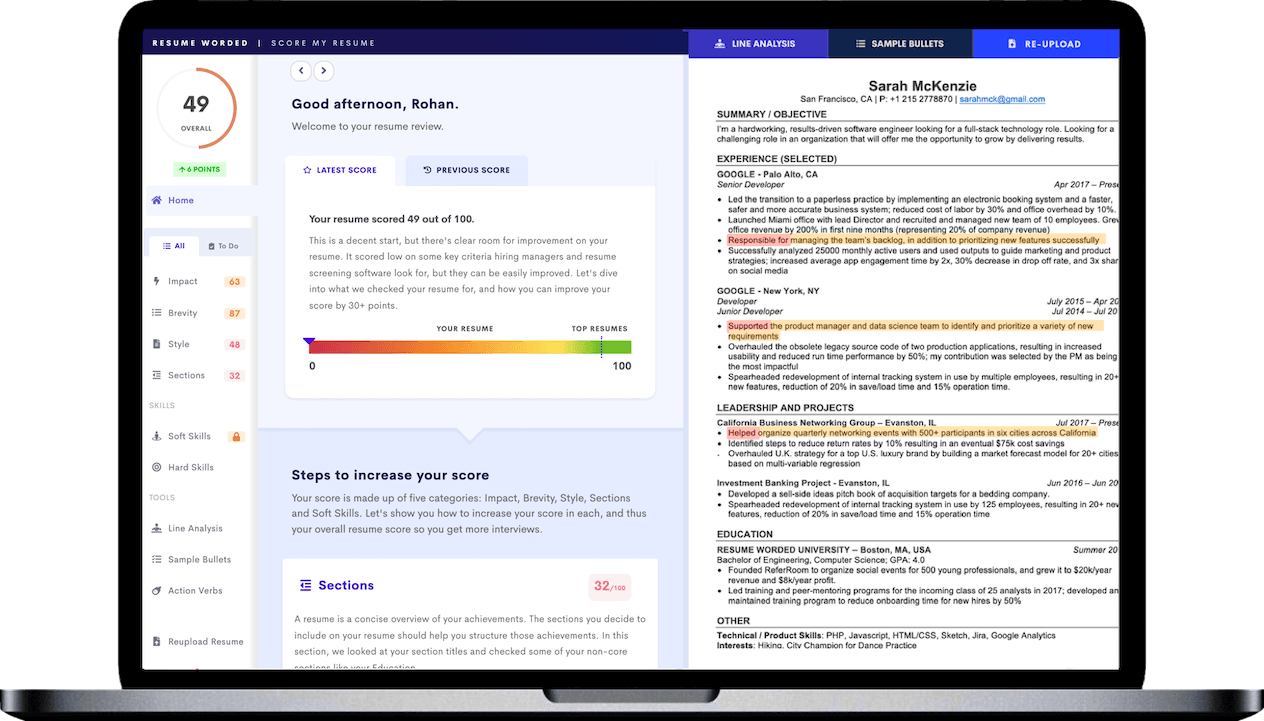
Experienced Professional transitioning to Customer Service Resume Objective Example
Leveraging leadership experience.
Even if you're transitioning to a different role, your leadership experience is still valuable. It shows that you understand the dynamics of a team and can guide others to achieve common goals. This can be particularly helpful if you're applying to a customer service role within a team environment.
Training and Motivating Teams
Showing your ability to train and motivate teams not only speaks to your leadership skills, but also your dedication to improving the overall performance of a team. This can translate well into a customer service role, as it shows your commitment to delivering the best possible service.
Increasing Customer Retention
Customer retention is paramount in any business. If you can show that you've been successful in keeping customers loyal, it shows that you understand the value of a long-term customer relationship and can create strategies to maintain it.
Recent Graduate for Customer Service Resume Objective Example
Demonstrating resilience.
Customer service can be tough. Customers can be difficult and even rude. By showcasing your ability to handle customer complaints, you're showing that you have the patience, resilience, and emotional intelligence to deal with challenging situations.
Driving Satisfaction
Customer satisfaction is the ultimate goal in customer service. By showcasing your ability to improve customer satisfaction, you're showing recruiters that you understand the significance of a satisfied customer and have the skills to achieve it.
Customer Service Resume Templates
Cloud developer.
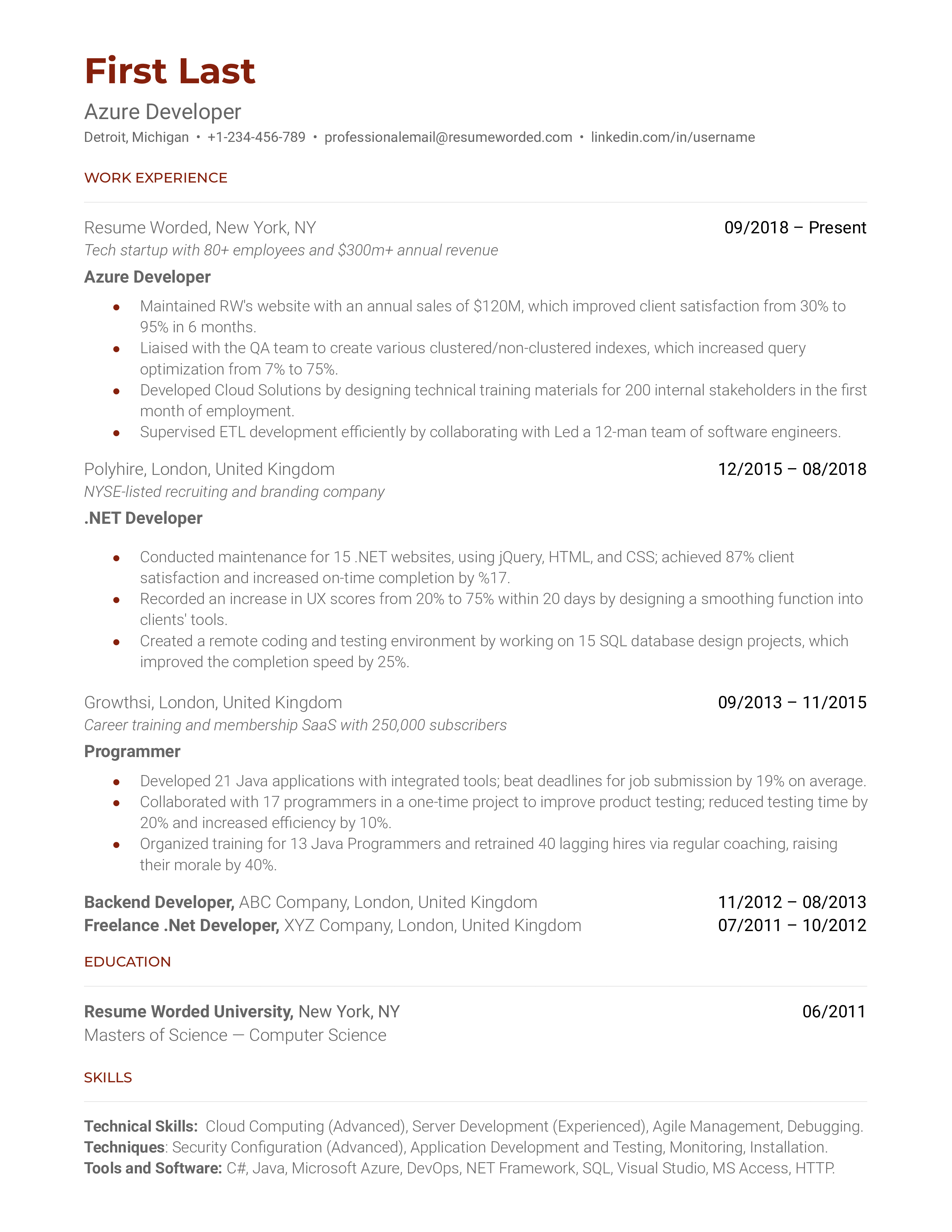
Relationship Manager
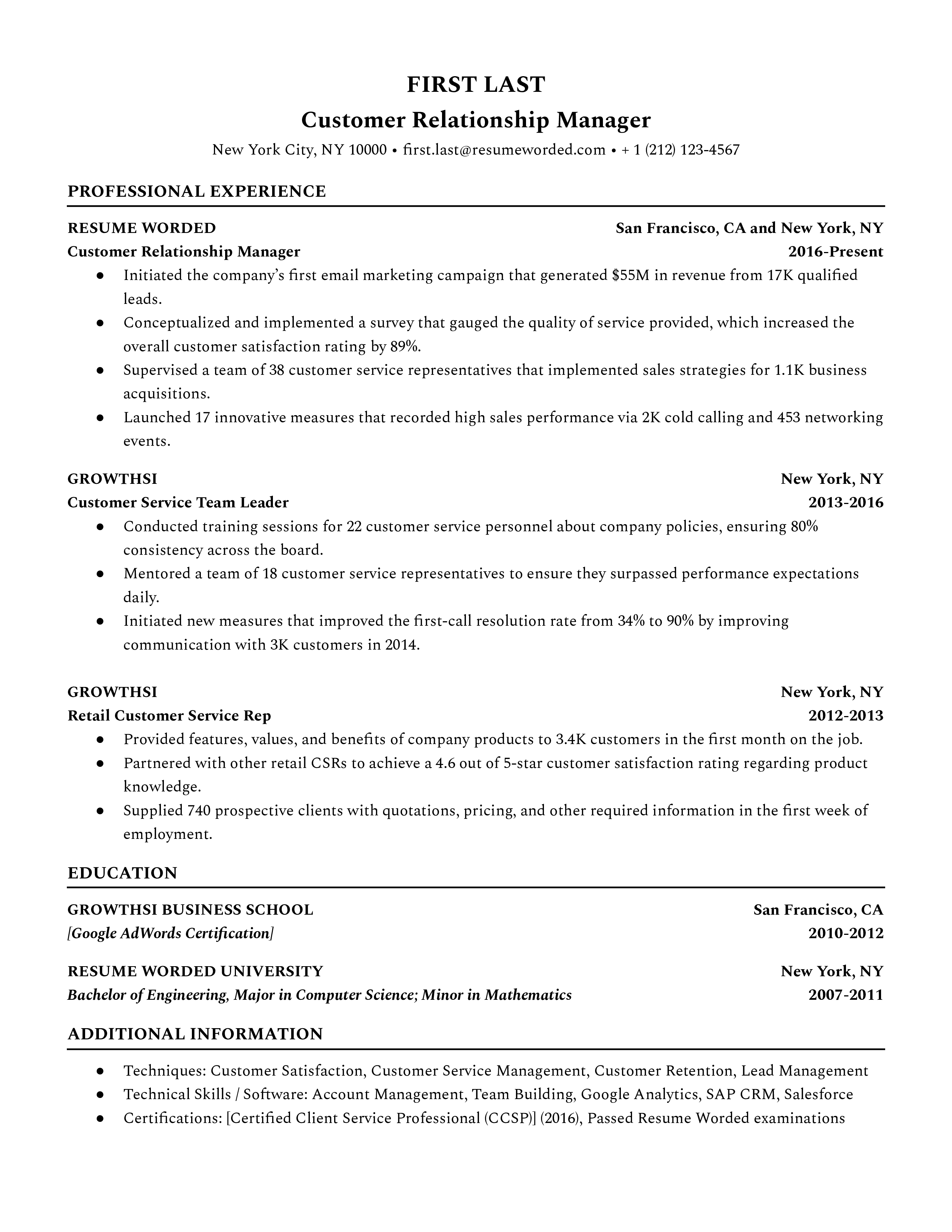
Service Technician
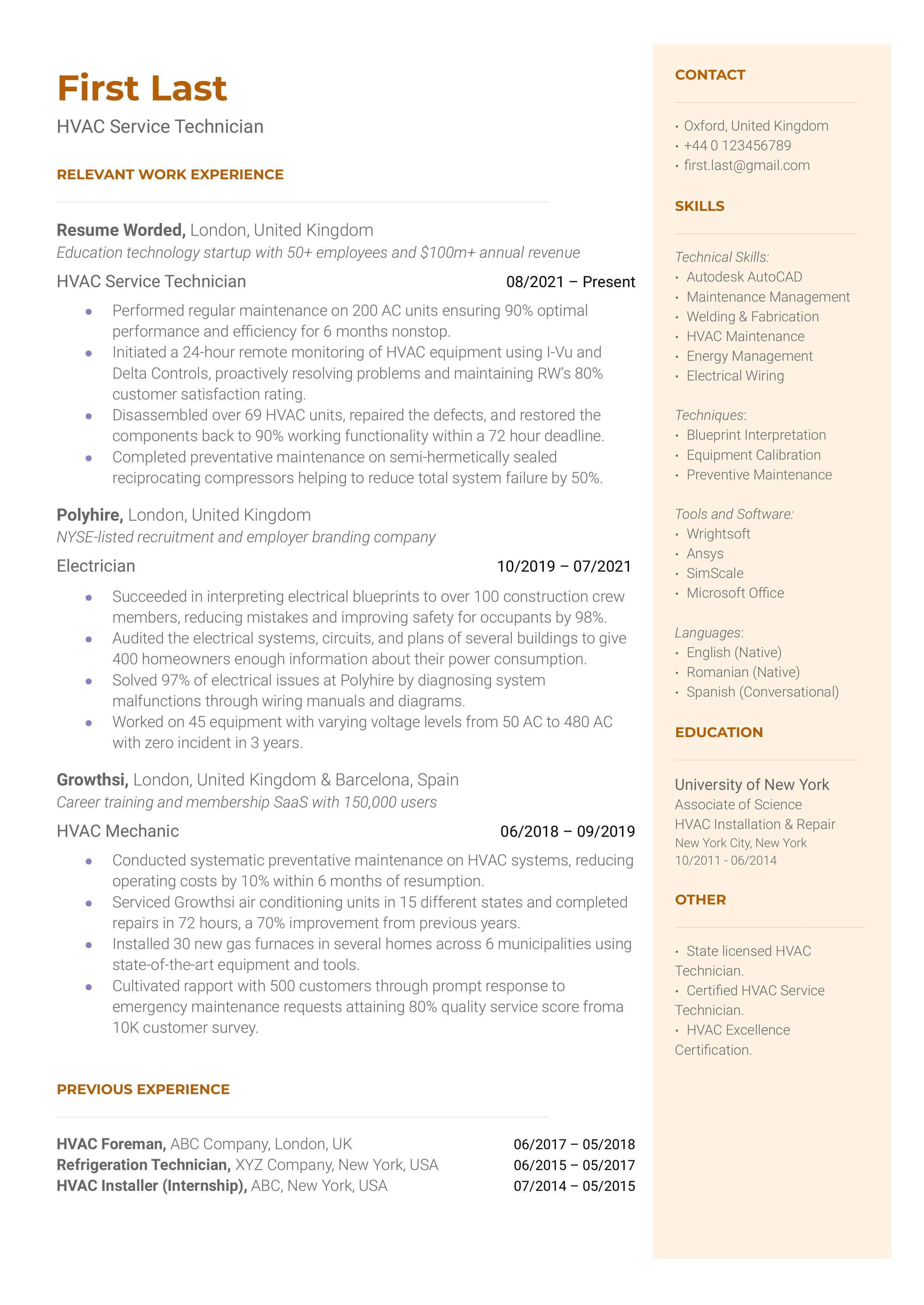
Administrative Resume Summary Examples
- > Administrative Assistant Summary Examples
- > Executive Assistant Summary Examples
- > Office Manager Summary Examples
- > Research Assistant Summary Examples
Administrative Resume Objective Examples
- > Administrative Assistant Objective Examples
- > Executive Assistant Objective Examples
- > Office Manager Objective Examples
- > Research Assistant Objective Examples
Administrative Resume Guides
- > Administrative Assistant Resume Guides
- > Executive Assistant Resume Guides
- > Office Manager Resume Guides
- > Research Assistant Resume Guides

Thank you for the checklist! I realized I was making so many mistakes on my resume that I've now fixed. I'm much more confident in my resume now.

Write a Killer Customer Service Resume Objective
Viktoriya maya, in this article, subscribe to our newsletter.
- First Name *
Write an Excellent Customer Service Resume Objective (Free Sample!)
To stand out in the highly competitive customer service industry you’ll need to know how to write a killer customer service resume objective. Crafting a top-notch objective statement is the best way to differentiate yourself and prevent your resume from being passed over by hiring managers. Luckily, this article is here to help you do just that.

Why You Should Include an Objective in Your Resume
The purpose of your objective statement may vary depending on where you are in your career. The general purpose is to provide a short description of your goals and what you can bring to a potential employer. This gives you an opportunity to show how your skills would be an asset in the position, even if you may not have direct experience in the industry. A good objective statement can make the difference between getting the job of your dreams or finding your resume lining the trash can of the HR department.
What Makes a Winning Objective?
The ideal objective statement should be concise, ideally only a sentence or two in length, and tailored to fit each job you apply for. It should quickly highlight who you are, what you offer, and your goals in a way that demonstrates value to potential employers.
A good objective should also reflect some level of understanding of the position and company you are applying to, for a customer service job this may include previous experience in the industry. If you don’t have experience it may also include relevant training you may have received or skills that could apply to the position. This small bit of customization will go a long way in showing hiring managers that you are a serious applicant and that you have done your research.
Writing a Professional C ustomer Service Resume Objective
Now that you know why you need a strong objective for your resume, you are probably wondering how to write one for yourself. Here are five simple tips that will help you get started:
#1. Know Your Goals
Customer service is a huge industry with a variety of roles available. When constructing your customer service resume objective, it’s important to have a clear direction in mind. For example, are you looking to work with customers face to face, in a call center , or in a virtual support type of role?

Knowing the specifics will allow you to further tailor your objective for the job you want. Narrowing your focus to only the most relevant skills, experience, and training will help your resume stand out.
#2. Demonstrate your value
It’s important to highlight your skills in the objective, but it’s more impactful if you also explain how you will use them to bring value to the company and carry out the required duties. Demonstrating how your skills are transferable to the new job can also help you show a deeper understanding of the position.
#3. Be concise
A good job will receive dozens, if not hundreds or even thousands of applicants. Competition means you will need to put in the work to make a positive first impression to stand out from other applicants. If your resume has a long objective, it’s not going to get read, and it might even get your resume pulled from consideration.
#4. Use the right keywords
In the interest of keeping your objective concise, you want to make sure every word counts, and that means using the right keywords. Every objective should include the name of the company you are applying to and the position as listed in the job posting. You can also look for keyword clues within the job posting, such as ideal qualifications, like experience working with specific software.
In a customer service resume objective, you may consider using keywords like communication, problem-solving, and conflict resolution .
#5. Adapt your Objective to Each Position and Company
It can’t be said enough. The single most important thing you can do when writing a resume objective is to write a new objective for every single job you apply for. If you want to stand out, customizing your objective is an effective way to do it. Each objective should highlight the skills and experience required for that job, and if possible, reflect the values of the company you are applying to.

Writing a Killer Customer Service Resume Objective: Dos and Don’ts
- Tailor the skills and qualifications you highlight for each job application.
- Include the company name and the title of the position you are filing for.
- Keep the objective short, no more than one or two sentences in length.
- Focus on how you can benefit the employer, not how they can benefit you.
- Avoid using vague statements that say little about your career goals (i.e. “looking for a job with opportunities for advancement”).
- Read and reread what you’ve written. Is it clear and concise? Does it make an impression?
- Reuse an objective statement to apply to multiple jobs.
- Omit the company name or leave out the title of the position you are applying for.
- Focus your objective on your wants and needs.
- Write a wordy unfocused objective statement.
Examples of High-Value Customer Service Resume Objectives
“Experienced customer service representative with 98.6% customer satisfaction rating over five years in a fast-paced call center role. Seeking the position of customer satisfaction manager with Smith Industries.”

“Hardworking hospitality graduate seeking the position of junior help desk associate at ICC Strategies.”
“Experienced human resources manager looking to use my extensive background in interpersonal relations and conflict resolution to add value to the customer relations team at J.R. and associates .”
Examples of a low-value customer service resume objective
“Customer service rep seeking employment with a large company with room to grow.”
“Recent graduate looking for work in a fast-paced team environment.”
“I am a friendly, hard-working, people person with five years of experience in customer support. Looking to secure a long-term employment opportunity with benefits in a team environment for a large company. I have experience working as a virtual assistant in call-centers and as a front desk manager at a major hotel chain for two years.”
Top Strategies For Writing A Customer Service Resume Objective
#1. create a long version.
The best way to construct an impactful and concise resume objective is to start by writing a longer version. Include everything you would like to communicate to the company and all of your relevant experience before paring it down to the bare essentials. It can be helpful to break down the information and rank it in order of importance for the specific position.
#2. Do Your Research
When you are trying to write an objective, it can be helpful to research the kind of work you are pursuing while looking out for recurring skills or other requirements. These recurring keywords will give you a good idea of what to focus on and which skills you should highlight in your objective.
#3. Get feedback
After you’ve written, read, and re-read your objective, it can be helpful to get an outside opinion before you submit your resume. A neutral party will have no attachment to what you’ve written and can offer unbiased feedback that can improve the quality of your objective.
5 Templates You Can Use to Craft Your Own Objectives
If you need a little more direction to get started writing resume objectives, check out the five templates below for inspiration:
- Dedicated customer service professional with [years of experience] looking to utilize my interpersonal and conflict resolution skills in the role of the position of [job title] at [company name].
- [Years of experience] working in the customer service industry in various roles. Looking to use my time management and communication skills to add value as a member of the support team at [company name].
- [Years of experience] working in a fast-paced call center setting where I maintained a 98.7% customer satisfaction rate. I’m looking to bring my problem solving, de-escalation, and communication skills to the help desk team at [company name].
- Experienced IT Professional looking to transition my problem-solving abilities, technical knowledge, and typing skills into a virtual support role with [company name].
- 2021 Communications graduate looking to apply my knowledge and experience in an entry-level help-desk position with [company name]. Feel free to use these templates, but remember to include the most relevant details for your position and skill set. Good luck job hunting!
Quick Summary
- A strong objective can improve your customer service resume and help you stand out.
- If you don’t have industry experience, a resume objective can help you transition careers.
- Resume objectives should be clear, concise, and tailored to each job you apply for.
- A good objective will focus on how your skills can benefit the employer.
- Your objective should always include specific details, like company name and job title.
Other Resources:
CustomersFirst Academy offers comprehensive customer service training designed to help you grow your skills and advance your career.
To keep learning and developing your knowledge of customer service, we highly recommend the additional resources below:
10 Transferable Retail Skills to Add to Your Resume How To Write A Successful Customer Service Cover Letter (Includes Free Sample) Top 10 Customer Service Rep Interview Questions Strategies to grow and keep your customer base
Share this post
Accelerate your success.

Career Resources
Communication skills, customer service.
- Empathy vs. Sympathy vs. Compassion: What’s the Difference?
- 10 Techniques To Enhance Your Client Relations Skills
- The Difference Between Verbal and Nonverbal Communication
- 10 Inspiring Quotes About Serving Others In Customer Service
- 7 Steps to Cultivating a Customer Service Culture
- Full Name *
Leave a Comment
Your email address will not be published. Required fields are marked *
Keep Reading
Become a certified customer service professional today, certifications for customer service: boost your career, top customer service certifications: customersfirst academy, essential customer service training – philippines, customer service training for hvac technicians and teams, customer service elearning: the future of professional development, stand out with a customer service certification, exploring the customer service representative certification, it help desk training: what you need to know, help desk resume: essential skills for success, canadian universities for international students: top picks and tips, top universities in canada for international students: pros and cons, the best certificate program for working in customer service, jobs that help people and pay well: the best careers for you, 10 best customer service jobs for introverts, how to get a job in canada for new immigrants 2022, courses and certifications.
At CustomersFirst Academy, we empower professionals with customer service training programs and in-demand industry skills that are practical and easy to implement.
Privacy Overview
- CustomersFirst Academy Masterclass
- CustomersFirst De-Escalation Training
- Free Resource Library
- Preparation Tips
- Interview Checklist
- Questions&Answers
- Difficult Questions
- Questions to Ask
Interview Tips
- Dress for Success
- Job Interview Advice
- Behavioral Interview
- Entry Level Interview
- Information Interview
- Panel Interviews
- Group Interviews
- Phone Interviews
- Skype Interviews
- Second Interviews
- Zoom Interviews
- Job Interview Guides
- Administrative
- Call Center
- Clerical Interview
- Customer Service
- Human Resources
- Office Manager
- Project Manager
- Restaurant Jobs
- Social Work
- Interview Follow Up
- Thank You Letters
- Job References
- Employment Tests
- Background Checks
- Character References
- Accepting a Job Offer
- Decline a Job Offer
- Verbal Job Offer
- Negotiate Salary
- How to Resign
- Job Search Strategy
- Job Search Tips
- Respond to Interview Request
- Letters of Recommendation
- Surviving a Layoff
- Sample Resumes
- Resume Objectives
Cover Letters
Job Descriptions
- Job Interview Blog
- Best Articles
Privacy Policy
- Customer Service Resume Objective
Customer Service Resume Objective Examples
Customer service resume objective examples that highlight the skills and strengths you bring to the customer service job opportunity.

Your resume objective statement or summary should clearly and quickly articulate why the employer should take your job application seriously. It is the most important paragraph in your resume so take the time to get it right.
We know that a resume objective statement that answers the question "Why should I read this resume?" is far more effective than the single sentence that outlines your career objective.
These persuasive summaries of what you can bring to the job opportunity can easily be edited for your own resume. Your customer service resume objective or summary should be relevant and targeted to each different job opportunity.
Customer Service Resume Objective Examples - Paragraph Format
Dedicated customer service professional with 5 years experience in a fast-paced environment seeking an opportunity in a team-orientated company. Adept at handling a wide range of contact methods while accurately documenting customer issues and providing first class service with every interaction.
Track record of quickly acquiring competency in all products and transactions while readily and positively adapting to change.
Energetic customer service specialist eager to obtain a position that makes full use of expertise in building customer relations. Advanced customer service experience includes successfully implementing innovative customer programs that increased the customer base by X%.
A high level of computer knowledge and proven competency in multitasking enables optimal performance in a challenging environment .
Customer Service Resume Objective Examples - Bullet Format
Self-motivated and resourceful customer service representative with proven competency in:
- resolving a wide range of product and service issues speedily and satisfactorily
- exceeding customer's post-sales needs with energetic follow-up
- maintaining composure while handling challenging customer demands
- learning new processes from beginning to end
Focused customer service agent looking for a new challenge in a results-driven environment. Expertise includes:
- solid experience in defining and analyzing customer requests to resolve issues accurately and quickly with high first contact resolution rates.
- strong computer skills in a Windows-based environment and proven ability to learn unique software.
- confident and effective communicator who receives excellent customer feedback.
Customer Service Resume Objective Statement - Useful Phrases
These sample resume objective phrases articulate the skills, strengths and achievements employers are generally seeking in customer service staff.
Personalize these to build your own customer service resume objective statement that clearly addresses the needs of the position you are applying for.
Actively seeking a customer service position where I can optimize my problem-solving and organizational skills to contribute to increased customer satisfaction.
Strong multitasking skills and fast learning ability ensure quick contribution to your customer service team.
Able to effectively communicate with customers using a multitude of channels to provide world class service with every interaction.
Recognized for proactively maintaining an in-depth knowledge of all products and promotions.
Able to work successfully as a team member and as an individual contributor.
Exceptional communication skills with the ability to remain calm and convincing in negative situations.
Solid track record of analyzing product failure for problem identification and prioritization of necessary corrective actions.
Documented increase in customer retention by delivering a fully-integrated customer service solution.
Able to efficiently navigate multiple systems while handling complex queries.
Track record of providing high quality customer-focused service using in-depth knowledge of products and processes resulting in enhanced customer retention.
Highly resourceful customer service professional willing and able to adapt effectively to a constantly changing environment.
Experience in working collaboratively with other departments to facilitate the best user experience.
A creative problem-solver who is energized by dealing with a variety of challenges in a fast-paced environment.
In-depth computer knowledge and competency in a wide range of CRM software.
Able to swiftly and accurately collect relevant data to determine solutions to customer issues.
Proven ability to grasp and apply new concepts quickly and effectively in a results-driven environment.

How to Create a Customer Service Resume and Cover Letter
Use this customer service resume template to complete a job-winning resume.
Send a well written customer service cover letter .
Entry Level Customer Service Resume
Customer Service Manager Resume
Call Center Resume
Customer Service Keywords for Resumes
Using the right customer service resume keywords ensures that your resume gets past the Applicant Tracking System and gets noticed by employers.

Customer Service Resumes

CUSTOMER SERVICE
Customer Service Resume

Help Desk Resume Sample
Customer Service Cover Letters

Customer Service Cover Letter

Call Center Cover Letter

Sample Cover Letter Template
How do you Describe Customer Service Skills on a Resume?
Gain a good understanding of the customer role and the duties and skills required in this job.
Customer Service Job Description
Definition of Customer Service
Customer Service Job Interviews

Customer Service Interview Guide

Customer Service Interview Q&A

Behavioral Interview Questions
Call Center Interview
Help Desk Interview
To Top of Page
Don't Miss These Latest Updates
Problem-solving is a key skill for today's workplace. Problem-solving behavioral interview questions
Compelling sample interview answers to "Why do you want to work for this company?"
11 essential supervisor interview questions and answers plus industry specific supervisor Q&A .
How to ask for a letter of recommendation with this sample email requesting letter of recommendation .
What are the top 10 reasons for leaving your job? Find out acceptable reasons for leaving a job.
Sample employment acceptance letter and email to properly confirm your acceptance of the job offer and employment contract.
What are your strengths? Find out the 11 essential workplace strengths at list of strengths and weaknesses
Interview Preparation
Interview Questions & Answers
Interview Guides
After the Interview
The Job Offer
Latest News
© Copyright 2023 | Best-Job-Interview.com | All Rights Reserved.

30 Examples of Customer Service Resume Objective
By Status.net Editorial Team on March 6, 2024 — 9 minutes to read
Crafting a strong customer service resume objective is a vital step in landing your desired role. An effective objective succinctly highlights your relevant skills and passion for helping others, setting the tone for the rest of your resume. When you’re writing your resume objective, you want to focus on what you can bring to the employer, showing that you understand the importance of customer satisfaction and possess the necessary skills to excel in a service-oriented position.
Understanding Resume Objectives
When you’re crafting your resume, your objective statement is your opening pitch. It’s the first thing employers read, so you need to make it count. Think of it as a quick snapshot of who you are as a professional and what you offer to the company.
Your objective should be specific to the role you’re applying for. For example, if you’re aiming for a customer service position, an objective like, “Seeking a challenging customer service role where I can utilize my problem-solving skills and commitment to excellent customer experience” directly relates to the job.
Remember, your resume objective is different from a summary. It focuses on your goals for employment, rather than detailing your past work history. While your objective can mention a key strength or skill, ensure it aligns with the job description.
Here are some elements you might include in a customer service resume objective:
- Specific Position : You’re applying for a customer service position, so state it.
- Skills : Highlight customer-oriented skills like communication, problem-solving, or conflict resolution.
- Experience : Mention relevant experience only if it strengthens your objective.
- Career Goals: Include how the position fits your career plans without overshadowing the company’s needs.
Examples of Effective Resume Objectives
When crafting your resume objective, you’re setting the stage for your professional narrative. It’s important to tailor this short statement to reflect your skills and goals, grabbing the employer’s attention right from the start.
Entry-Level Objectives
If you’re starting your career, your resume objective should highlight your enthusiasm and dedication to learning and contributing to the company. For example:
- “Eager to bring fresh and innovative ideas to a dynamic team at [Company Name] as a Junior Developer, leveraging recent training in full-stack development and a commitment to building user-friendly applications.”
- “Aspiring Customer Service Specialist with a strong academic background in Communication Studies, aiming to leverage my problem-solving skills and passion for helping others to enhance client relationships at [Company Name].”
Experienced Professional Objectives
As an experienced professional, your resume objective can reflect your expertise and how you can add value to the employer’s organization with your seasoned skills. Consider these examples:
- “Seasoned Marketing Manager interested in bringing over 10 years of experience in campaign development and team leadership to [Company Name], driving impactful brand strategies and boosting market presence.”
- “Dedicated Nurse Practitioner with a decade of experience in patient care, committed to offering compassionate and evidence-based treatment to patients at [Healthcare Center or Hospital], with a focus on preventive care and patient education.”
Your resume objective is your chance to make a great first impression. You’ll want to be precise, align with what the employer is looking for, and showcase the best of your abilities and experience right at the top of your resume.
Tailoring to the Job Description
To engage the hiring manager quickly, you can mirror language from the job description in your resume objective. This shows you’ve read and understood the job posting, and your skills match their needs.
- Experienced customer service representative seeking to leverage strong communication skills and a track record of maintaining customer satisfaction from the job description in a fast-paced retail environment.
- Looking for a customer service role where I can apply my experience handling complex queries detailed in the job description to improve customer engagement for the company.
- Eager to bring my detailed-oriented nature and exemplary problem-solving abilities mentioned in the job listing to a dynamic customer service team.
- To join a tech-savvy support team, as described in the job posting, where I can contribute my extensive knowledge of software products to enhance user experience.
- Aiming to utilize my proven patience and communication skills, as required by the role, to provide exceptional service at [Company Name].
- Intent on using my multilingual skills and hospitality background from the job description to enhance customer satisfaction at [Company Name].
- Pursuing a customer service position with [Company Name] where my commitment to addressing customer needs as described can drive loyalty and growth.
- Seeking to apply my strong organization skills and attention to detail, as the job demands, within a customer support role at a fast-growing tech company.
- Dedicated to bringing my conflict resolution abilities and positive attitude, which are highlighted in the job advertisement, to a rewarding customer service position.
- Motivated to join [Company Name] where my track record of increasing customer retention, as laid out in the job needs, can be put to excellent use.
Highlighting Your Skills
In customer service, certain skills make you stand out. Here’s a list of phrases you can use, each featuring a different key skill:
- Bringing to the table exceptional interpersonal skills and a commitment to customer satisfaction.
- Offering adept problem-solving abilities to handle even the most challenging customer inquiries.
- Proven expertise in using CRM software to streamline customer interactions and maintain organized records.
- Seasoned in providing support via phone, email, and live chat, ensuring comprehensive assistance across all channels.
- Adept at multitasking in fast-paced environments to meet and exceed customer service goals.
- Keen ability to quickly adapt to new products and technologies to provide informed customer support.
- Strong work ethic and a team player attitude to positively contribute to a cohesive customer service unit.
- Capable of fostering positive customer relations, building loyalty, and increasing customer engagement.
- Committed to maintaining customer confidentiality and ensuring secure handling of sensitive information.
- Proficient in conflict resolution, ready to diffuse tense situations and promote a calm service environment.
Showcasing Experience
Your experience can be a testament to your abilities.
- Bringing three years of high-volume call center experience to the customer service role at [Company Name].
- Offering extensive experience in face-to-face customer service within the retail sector, aiming to bring that expertise to [Company Name].
- Ready to apply five years of experience in the hospitality industry to improve customer satisfaction rates at [Company Name].
- Transitioning seven years of freelance customer support experience to a dedicated full-time role with your team.
- Applying a decade of management experience in customer service departments to lead and inspire your team.
- Ready to transfer a diverse background of customer support in tech, retail, and telecommunications to your company.
- Leveraging my track record of improving first contact resolution rates in previous customer service roles.
- Looking to utilize four years of experience in a supervisory customer service position to foster team excellence at [Company Name].
- With a history of successfully managing customer service for a startup, I’m ready to bring that growth mindset to your company.
- Aim to enhance customer service strategies with over eight years’ experience leading successful teams.
Common Mistakes to Avoid
When crafting your customer service resume objective, you might be tempted to emphasize your desire to get a job, but you should instead focus on how you can meet the needs of the employer. For example, avoid statements like “ I want to improve my skills at a reputable company ” and instead try “ Dedicated customer service professional aiming to contribute to (…) Company’s customer satisfaction goals with proven communication skills. ”
- Steer clear of vague phrases. For instance, rather than saying “ I am a hard worker, ” use specific examples to demonstrate your work ethic, like “ Consistently met customer service satisfaction scores above 95%. “
- Keep your objective statement short and avoid lengthy paragraphs. A good rule of thumb is to keep it under two to three sentences. Your goal is to quickly show your potential value to the hiring manager, not to provide your entire work history.
- Resist the temptation to use overly technical jargon or acronyms unless you are certain they are common in your field. If you’re applying for a role in a specific industry where certain terms are well-known, it’s fine to use them, but in general, plain language is more accessible.
- Proofread your resume objective to avoid typos and grammatical errors, which can make you seem careless. Also, failure to customize your objective for each role could convey a lack of genuine interest in the position. Tailoring your statement to the job and company shows that you’ve done your research and understand what they’re looking for.
Tips for Polishing Your Objective
- Try to tailor your objective for each job application. Highlight particular strengths that match the job description. If the job emphasizes teamwork, mention your collaborative skills.
- Use action words to convey energy and enthusiasm. Words like “achieve,” “deliver,” and “enhance” can be powerful starters. Related: Writing a Summary of Qualifications: Examples & Action Words
- Keep your customer at the forefront. After all, your role is about service. Phrase your objective to reflect that your priority is their satisfaction. You might say, “Aiming to deliver exceptional customer service and support by efficiently addressing customer needs and feedback.”
- Show off your industry knowledge with specific terms. Mention if you’re familiar with any CRM software, chat platforms, or other customer service tools.
Your resume objective should be tailored to reflect your unique strengths and the specific job you are applying for. It’s important to use keywords from the job description and to be clear about what you aim to achieve in the position.
Frequently Asked Questions
What can i put as an objective on my resume if i’m new to customer service.
For your first foray into customer service, focus on your eagerness to learn and contribute. For example, you might write “Enthusiastic and personable individual seeking a Customer Service Representative position to leverage my strong communication skills and commitment to providing excellent customer support.”
How should I craft a resume objective for a customer service position with no prior experience?
Highlight your transferable skills, such as problem-solving and active listening, which are vital in customer service. Example: “Seeking a role as a Customer Support Specialist where I can apply my adeptness at resolving conflicts and my ability to work well under pressure.”
What are some good objectives to include on a resume for a customer service role at a call center?
When applying for a call center role, showcase your ability to handle high call volumes gracefully. An example objective could be “To obtain a position as a Call Center Representative where I can employ my proficiency in customer care and my excellent verbal communication skills.”
How do I write a compelling customer service resume summary for a retail position?
Your summary should reflect your understanding of retail service excellence. An example might be “Customer Service enthusiast with a passion for fostering long-lasting client relationships and a proven track record in a fast-paced retail environment looking to bring dedication and an outstanding work ethic to XYZ Retail.”
Can you provide examples of effective resume objectives for fresh graduates applying for customer service jobs?
Fresh graduates should highlight their academic achievements and relevant skills. Example “Recent graduate with a Bachelor’s in Communication eager to contribute to (…) Company’s customer service team with strong interpersonal skills and a commitment to improving customer satisfaction.”
What should I include in a customer service resume objective if I have extensive experience?
For those with significant experience, it’s important to bring attention to your track record and leadership qualities. An objective like “Seasoned customer service professional with over 10 years of experience in resolving complex customer inquiries seeking a managerial role to drive customer loyalty and team efficiency at ABC Corp.” would be appropriate.
- 3 Examples: How to Write a Customer Service Resume Summary
- 40 Customer Service Self Evaluation Examples
- How to Deliver Excellent Customer Service (with Examples)
- 2 Examples of Customer Service Representative Cover Letters
- Customer Service Skills: Performance Review Examples (Rating 1 - 5)
- Empathy in Customer Service (50 Example Phrases)

Top 25 Customer Service Resume Objective Examples

This post provides a guide on how to make a compelling customer service resume objective statement, as well as great examples, to help boost the effectiveness of your resume and increase your chances of being hired for the customer service position that you are seeking.
Before your resume or CV can convince the recruiter that you are the best candidate for the customer service job, it must begin with a superior objective statement.
It is essential to have the employer get into your customer service resume and read it to the end, and not just a part of it.
This will make your offer clear before the recruiter and increase your chances of being invited for interview.
With what you learn from this post, you can make an effective career objective statement for your resume and make your chances for recruitment for the customer service role brighter.
How to Make a Great Customer Service Resume Objective Statement
To make an eye-catching resume objective for a customer service position, you need to know what exactly the recruiter wants.
Once you are able to give the recruiter exactly what they want their right candidate for the customer service position to have, they will be interested in your resume and want to read it to the end.
The recruiter or employer normally has a set of specific standards and requirements that applicants should meet to qualify to access the available customer service position.
So, in writing a great customer service resume objective, you need to focus on offering the recruiter exactly what they have specified in the job requirements.
In their advertisement for the available customer service position, recruiters usually provide a description of the available position that shows the duties the successful applicant will be expected to perform, as well as the requirements to be met to be hired.
The above information will help you make an objective statement that will assure the recruiter that you are the right candidate for the customer service role in their organization.
To do this, you need to study the information provided in the job description and requirements about the vacant customer service position to gain knowledge about the job and the type of applicant the recruiter really wants to employ.
Some of your best qualities, education, and/or experience should be highlighted in your objective statement, and they should meet the recruiter’s requirements for the customer service position.
Now, here are some good examples to help you write an irresistible objective for a resume seeking a customer service job:
Top 25 Customer Service Resume Objective Samples
- To obtain a Customer Service position with Anthem, Inc. to leverage strong ability to analyze problems in order to provide solutions; operate a PC/image station to obtain and extract information; and document information, activities and changes in the database. Also bringing 5 years experience in customer service, including excellent verbal and written communication, as well as problem solving skills.
- Passionate individual seeking a Customer Service position with Americold; bringing the ability to process orders and handle complaints in a prompt, courteous, and efficient way; greet visitors, telephone responses, and scheduling; experienced working with challenging customers, including ability to handle multiple tasks at the same time, work in a fast environment, and relate to other people beyond giving and receiving instructions.
- Safety conscious individual with high level of skills and experience. Desirous of a Customer Service position with Waste Management to utilize 5 to 10 years of experience levels in the job. Bringing the ability to listen to customers, understand their needs and provide solutions. Also coming with ability to manage a high volume of incoming calls from customers while navigating multiple systems to assist in answering questions and resolving issues, and communicate effectively and professionally with customers in a conversational manner.
- Individual with strong ability to learn fast interested in the position of a Customer Service Representative at AT&T; to apply 5 years experience answering customer/client requests or inquiries concerning services and products, utilizing different tools and systems to assist customers. Offering ability to make recommendations according to customer’s needs and continually maintain working knowledge of all company products, services and promotions, as well as problem solving, verbal and phone skills.
- Talented individual seeking to work with United Airlines Inc. as a Customer Service Representative with the ability to make United passengers reach their various destinations well satisfied, ability to work any schedule or shift, and comfortable working with computers. Also bringing physical ability to stand and walk for an eight-hour shift, as well as lift and handle baggage.
- Hopeful to gain employment with Axia Women’s Health as a Customer Service Rep to show positive work ethic and model the behaviors that have generated 95 percent patient satisfaction rate. Also bringing ability to adapt to changing priorities and business needs, demonstrate effective verbal and written communication, pursue activities with focus and drive, and adhere to standards of business conduct and compliance.
- To obtain the role of Customer Service Rep with Allstate to leverage ability to create, analyze, and resolve customer incidents, trends or requests; identify, locate, isolate, and resolve or repair problems within scope of specialty; and investigate, recognize, resolve and/or report technology trends. Also coming with oral and written communication skills, customer support skills, interpersonal skills, as well as organizational and troubleshooting skills.
- Highly skilled individual with ability to use office equipment and software to receive and respond to customer requests and complaints, document needs and concerns, and refer customers to other parties. Coming with skill in the use of service-oriented phrases and techniques to achieve resolution, skills in listening actively to discern customers’ needs, as well as ability to communicate effectively both orally and in writing, and ability to work effectively with others, evaluate customer information to determine course of action, and perform accurate computations and verifications of data.
- Creative and problem-solving professional desirous to join a group of technicians at XPO Logistics in the position of a Customer Service Representative. Coming with effective communication skill; customer service experience, strong computer, typing and 10-key skills; ability to work a variety of shifts, including days, evenings, nights and weeks, as well as ability to recognize and resolve documentation errors, and perform general clerical duties as assigned, including answering and directing phone calls, filing, data entry and billing.
- Flexible and energetic individual with huge knowledge and experience in customer service functions, seeking the position of a Customer Service Representative with AETNA. Coming with ability to maintain and continuously improve the quality system and achieve quality objectives through daily actions; knowledge of basic chemistry, electronics, electro-mechanical systems, and information technology; as well as effective customer service skills, which includes positive attitude and helpful customer interaction.
- Active individual with huge customer service skills and ability to provide customer support and information to customers, potential customers, sales representatives and others. Seeking to apply 5 years experience in a clinically-oriented environment and in customer service call center and sales environment as a Customer Service Rep with PTS Diagnostics, Inc. Coming with ability to document calls received from internal and external customers, educate customers on proper usage of the PTS Diagnostics product lines, and perform order entry, order tracking, backorder resolution, expecting orders and sales reporting.
- Highly talented Customer Service Representative is desirous of a position at Indiana Farm Bureau Insurance where the knowledge and understanding of basic mathematical skills will be applied. An enthusiastic candidate with 5 years experience working in an office setting and delivering customer service, as well as experience with PC software applications including Microsoft Office Suite, Internet Explorer, etc.
- Looking for the position of a Customer Service Representative with Young at Heart Pharmacy to process and manage customer requests via email and phone, researching and providing answers. Also coming with ability to access multiple technical resources in order to research and resolve problem, communicate with other departments to resolve issues and provide appropriate feedback to clients, as well as maintain a positive attitude and team approach towards customers and internal departments.
- Hopeful to gain employment with Meggitt as a Customer Service Representative to perform routine customer account administration through business unit Material Requirements Planning system (SAP or other), maintain efficient communication with customers to ensure timely resolution of customer service related issues, and provide reports relating to customer account history for the strategy, sales, and marketing teams.
- Individual with strong reasoning abilities looking to obtain the job of a Customer Service Specialist at XYZ Company, to answer customers’ questions effectively and provide guidance; assist with the daily opening and closing of the branch; and check transactions to ensure accuracy, timeliness, and proper accounting; and work with leadership to resolve escalated customer concerns and system problems. Also bringing 5 years of customer service experience, top-notch communication skills, a high level of critical thinking, and the ability to troubleshoot, process cash and card transactions as well as travel up to 20% of the time to branch locations; and perform training and branch-related community activities.
- Team oriented individual eager to work at City of Allen in the position of a Customer Service Officer; bringing ability to provide customer service to the public by answering telephones, answering questions, processing different applications and paperwork, taking fees or payments, and providing information as required. Also coming with ability to receive, receipt and record payments, process cash collections for other departments, receive deposits and fees, balance the cash drawer and paper the bank deposit, as well as reading, math, writing, managerial, interpersonal, and organizational skills.
- Passionate individual hopeful for a Customer Service position with Progressive Inc. to help customers with their requests and flourish in a fast-paced environment. Also coming with five years of college education, experience in customer service, sales, changing environment, multitasking and time management, effective communication both verbally and in writing, as well as computer skills.
- Seeking an Entry Level Customer Service position with Circle-E where solid knowledge of computers and computer programs, the capability to work in a very structured environment and maintain high level of professionalism, excellent work ethic, and personal accountability will be applied. Also bringing proper telephone etiquette, good typing, data entry and spelling skills, good organizational and time management skills, as well as exceptional ability to work independently.
- Extremely organized individual interested in securing a Customer Service position with Citi; bringing ability to assist customer service inquiries and provide solutions based on client needs in coordination with customer service functions. Also coming with exceptional ability to provide assistance with the delivery of a range of products and services to Citi’s clients under general supervision, as well as proficiency in Microsoft Office and Windows Operating Systems.
- Individual with strong reasoning abilities looking to contribute profound experience in the customer service job at Synchrony as a Customer Service Representative. Coming with excellent communication, problem-solving and analytical skills; proficient computer skills, ability to manage information in multiple windows, and ability to proficiently type while talking; and strong ability utilizing Microsoft Outlook.
- Seeking the job of a Customer Service Representative at XYZ Company where ability to deliver a highly satisfying customer experience, ability to handle high volume calls pleasantly and efficiently, and ability to keep sensitive information confidential will be utilized. Also coming with multi-language capability, strong computer skills, capacity to learn new software, ability to assist clients by gathering accurate information and connecting them with an Interpreter over the phone, as well as ability to work remotely in emergency situations.
- Experienced individual seeking an Entry Level Customer Service position with Syncreon. Coming with ability to ensure all daily customer services contacts and queries received via telephone and email are worked through to resolution per strict SLA’s. Also bringing fluency in oral and written English, ability to work as part of a team, excellent knowledge of the Microsoft Office suite, as well as excellent interpersonal skills, experience in carrier network management, and attention to detail for billing, process analysis, customer complaints investigations and reporting activities.
- Certified customer service representative with ability to provide service to people seeking assistance with post-order issues such as returns, replacements, refunds, delivery status, and back order inquiries. Longing for a customer service position with Wayfair, to troubleshoot and resolve customer service inquiries while building a relationship with the customer.
- Team oriented individual willing to work at VIPdesk Connect as a Customer Service Representative, bringing 5 years customer service experience, associate degree, proficiency with Microsoft Office suite, basic user knowledge of audio/wireless microphone systems, headsets, audio devices, gaming systems, excellent interpersonal skills, strong oral and written communication skills, and ability to handle customer inquiries via all channels including phone, email, SMS, chat, etc.
- Energetic individual with experience working with a PC and in a windows environment, ability to flexibly work any shift, and ability to type 20 WPM and 30 WPM. Seeking to apply five years of experience as a Customer Service Representative with General Dynamics Information Technology. Coming with ability to communicate effectively in English, both verbally and in writing; prioritize and complete tasks to meet contract standards; and provide knowledgeable responses to escalated, high priority, or supervisor calls in a courteous and professional manner.
Customer Service Skills, Abilities, Knowledge, and Experience for Resume Objective
Here are major qualifications for customer service positions, including skills, abilities, knowledge, training, and experience that you can apply in making your objective statement:
- Solid knowledge of customer service practices and requirements and of call center
- Strong knowledge of standard office equipment
- Knowledge of standard office protocols and procedures
- Profound computer proficiency and data entry skill
- Strong telephone etiquette
- Exceptional interpersonal communication and oral communication skills
- Basic writing and mathematics skills
- Strong ability in conducting research
- Profound Microsoft Office Suite skills
- Excellent time management ability and profound ability to multi-task
- Strong ability to listen attentively and be patient, to manage high call volumes
- Exceptional ability to handle stressful situations in a fast paced setting
- Profound ability to handle crisis situation and diffuse inflamed situations
- Strong ability to show empathy and compassion and apply critical thinking to customer concerns
- Experience working in a call center environment or in a service based industry.
Your resume must have a highly convincing objective statement to stand a better chance of being read if you are searching for a customer service job.
The ideas and examples shared on this page will help you to make a great resume objective for a customer service position that you are seeking.
Recommended:

This Site Uses Cookies
Privacy overview.
Build my resume
- Resume builder
- Build a better resume in minutes
- Resume examples
- 2,000+ examples that work in 2024
- Resume templates
- 184 free templates for all levels
- Cover letters
- Cover letter generator
- It's like magic, we promise
- Cover letter examples
- Free downloads in Word & Docs
26 Customer Service Resume Examples for 2024
Customer Service Resume
- Customer Service Resumes by Experience
- Customer Service Resumes by Role
- Writing Your Customer Service Resume
As the face of the organization, the customer service team is instrumental in building and maintaining a business’s reputation.
To be a successful customer service professional, you must have a wide-ranging skillset—patience, empathy, critical thinking, and detailed knowledge of your company’s products or services.
With such a tall order, you shouldn’t also have to be an expert at building a resume . Our easy resume tips are available at your fingertips!
We’ve analyzed countless resumes and chosen the 26 best customer service resume samples to help you land your next job in 2024 .
Furthermore, we’ll share our recommendations and advice so you can put your best foot forward on your resume; before you know it, you’ll also be ready to tackle your customer service cover letter !
or download as PDF

Why this resume works
- The best way to do this is by making your points concise and highly relevant to the job to which you’re applying. If you include a resume summary , tailor it to the business to which you apply. As a rule of thumb, the more you customize and fine-tune your resume for each job application, the more likely you are to get an interview.
Entry-Level Customer Service Resume
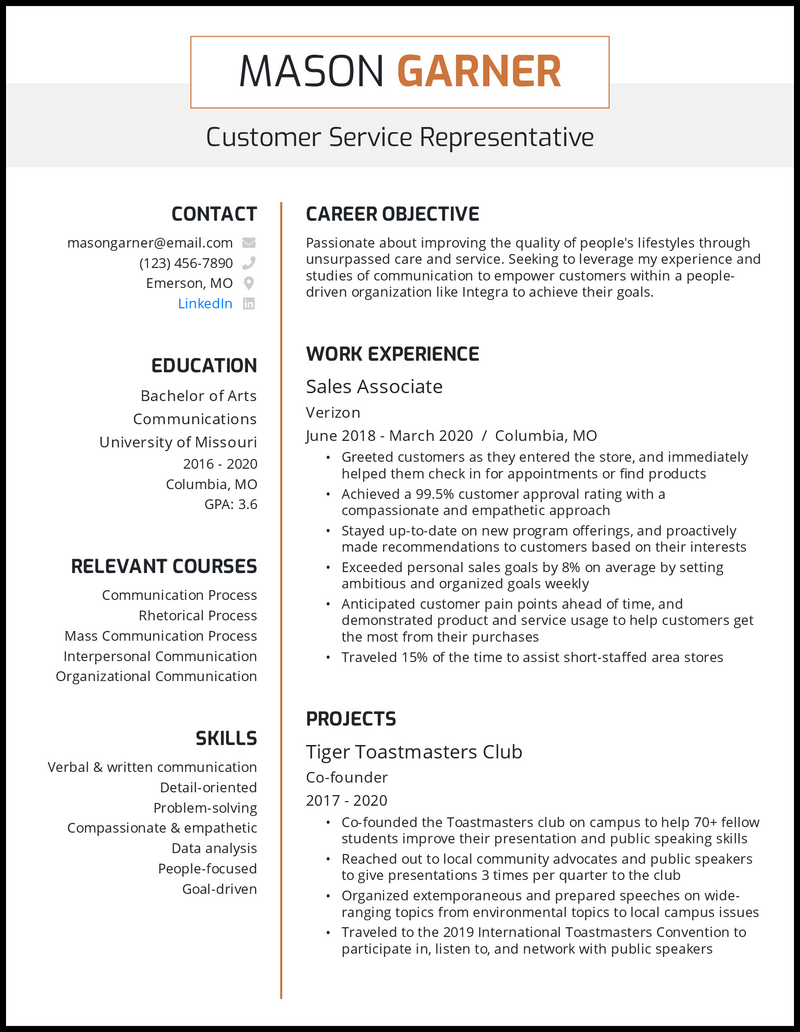
- Choose two tastefully contrasting fonts: one for your section headers, and one for your body text.
- Leverage white space throughout your resume to give it a clean, easy-on-the-eye, professional feel.
- We suggest bold (but not garish) colors in the header and titles to draw attention.
- Say goodbye to excess white space by adding some relevant projects you’ve worked on.
- Just make sure they relate to the customer service job description and emphasize your most relevant skills.
Customer Service Associate Resume

- Something very impressive on a customer service associate resume is when you’ve gone the extra mile to be certified. Definitely include any licenses or certifications you have in a dedicated “Certifications” section.
- Our user-friendly resume templates and Google Docs resume templates allow you to quickly add a section just for certificates and licenses.
- For example, “Handled an average of 40+ customer complaints per day with a 93% customer satisfaction rate.”
Customer Service Manager Resume

- Don’t worry though! You can easily tailor it by mentioning the specific job title you’re seeking, the company’s name, and any position-specific skills you’ve learned.If these kinds of details paralyze you, take a breath; now, start off your resume-building adventure with one of our free resume templates or Google Docs interactive resumes that already have sections laid out for your objective.
- Though including a resume objective is optional, we recommend one if you’ve had a career change, are entry-level, or simply need to effectively fill a little space on your resume.
- If you choose to add it, make sure it’s unique and personalized for every application you submit. That’s right. Every single one.
Customer Service Lead Resume

- Also, a technical support specialist position might have refined your problem-solving skills and technical knowledge, essential for resolving issues beyond the first line of support. A moment or two when your leadership stance shone brightly is a welcome addition to your customer service lead resume.
Airline Customer Service Resume

- In the same line, use larger fonts to draw the hiring manager’s attention to different essential parts of your resume. For example, role titles should be in a larger font and title case format, while terms accentuating your skills, hobbies, contact information, and education should be in uppercase.
Customer Service Call Center Resume

- It’s fine even if you mention them in other unrelated job roles. Just ensure that you clearly state how your assistance helped customers in a particular scenario.
- If you run out of room in your resume, remember that a cover letter generator can help you expound quickly on the details you care about sharing.
Customer Service Bank Resume

- Even if it’s only a short stint, mention how you went beyond resolving technical issues at a desk by adding your ability to make personalized follow-ups, maintain high-data accuracy rates, and implement any customer feedback provided.
Insurance Customer Service Resume
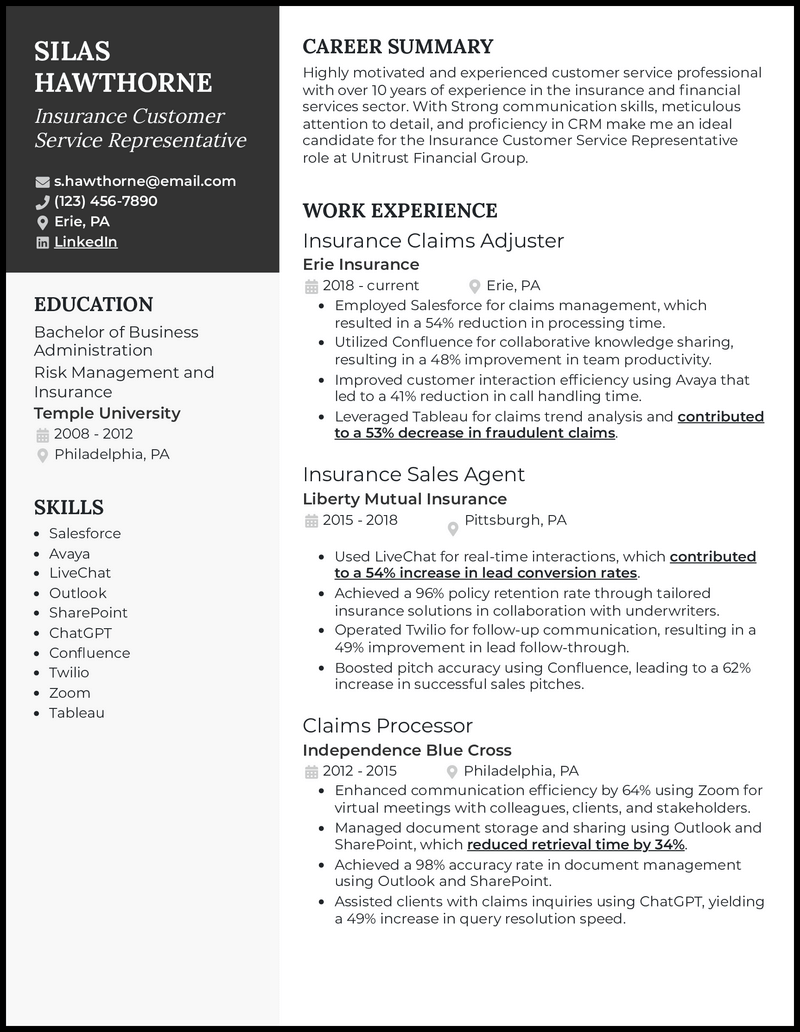
- Remember that expertise in communication efficiency, accurate responses align well with the requirements of the role since you will be handling customers.
Client Service Manager Resume

- And if you may, add your metrics on improving customer satisfaction to further prove your potential.
Customer Service Specialist Resume

- Luckily, customer service is typically a metric-heavy role. From sales to customer reviews to retention, there’s a lot of numbers you can draw upon, such as customer satisfaction scores, how many customers you helped, and sales targets you exceeded.
- Metrics draw the eye of the resume reader and increase the length of time they’ll review your customer service specialist resume , which increases your likelihood of getting an interview. Since a hiring manager will, on average, spend six seconds reviewing your resume, hooking their attention quickly is key.
Retail Customer Service Clerk Resume

- The structure of your retail customer service resume can either help or hurt the flow of the employer’s reading experience and affect whether or not you get that interview.
- We suggest you experiment with an array of resume templates and go for the one that zooms in on your greatest selling points.
- Sprinkle in impressive numerical metrics such as team headcounts, sales targets met, and payment processing accuracy percentages whenever possible.
Customer Success Manager Resume
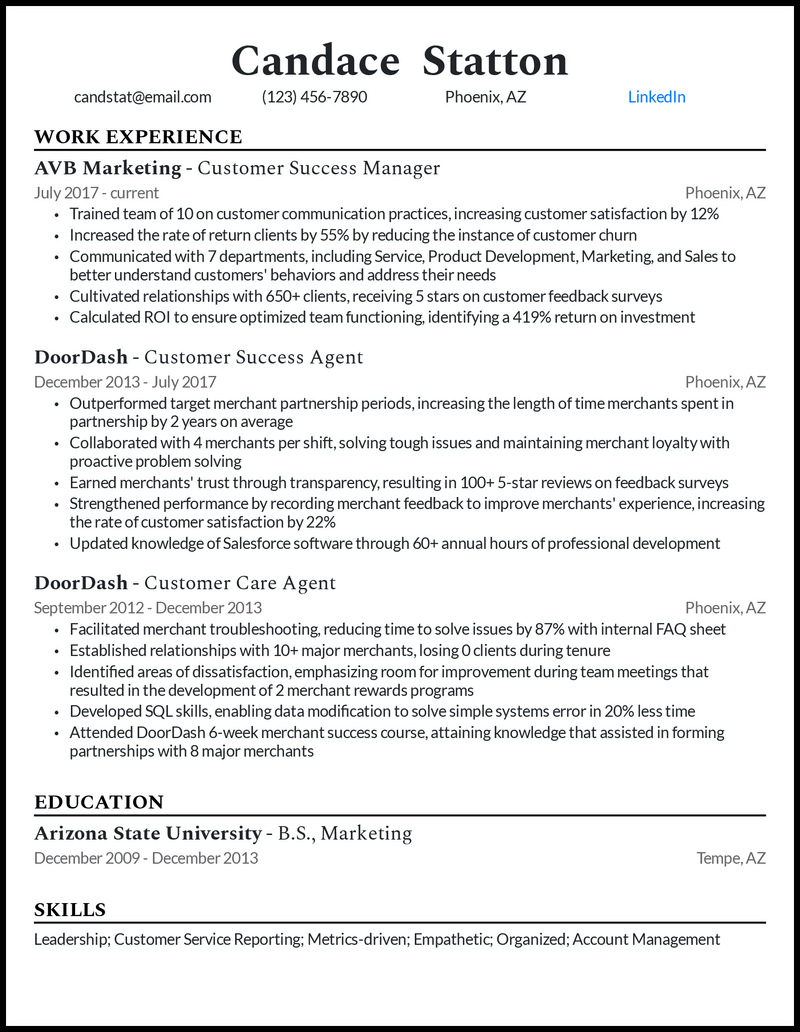
- Challenge yourself to prove your impact with metrics.
- For example, how much time did you save in labor hours? How much did you increase profits for the company? Provide any details that show how quickly you could boost numbers at the next business that’s smart enough to hire you.
- Striking a good balance between hard and soft skills is tricky, but doable—the skills section on your resume can emphasize the soft skills that made those impressive numbers happen in the first place.
Bilingual Customer Support Resume

- For example, you can mention the number of reward program members you signed on, the number of customers you helped per shift, the number of performance-based awards you earned, and the percentage of bilingual clients who specifically returned to you for assistance.
- Pass the automated tracking system filter by peppering your skills section with relevant keywords you’ve taken the time to mine from the job description .
- Just be sure the keywords you glean from the job description truly match the skills you possess! Better to be a master of a few talents than have a surface knowledge of many.
Customer Service Consultant Resume
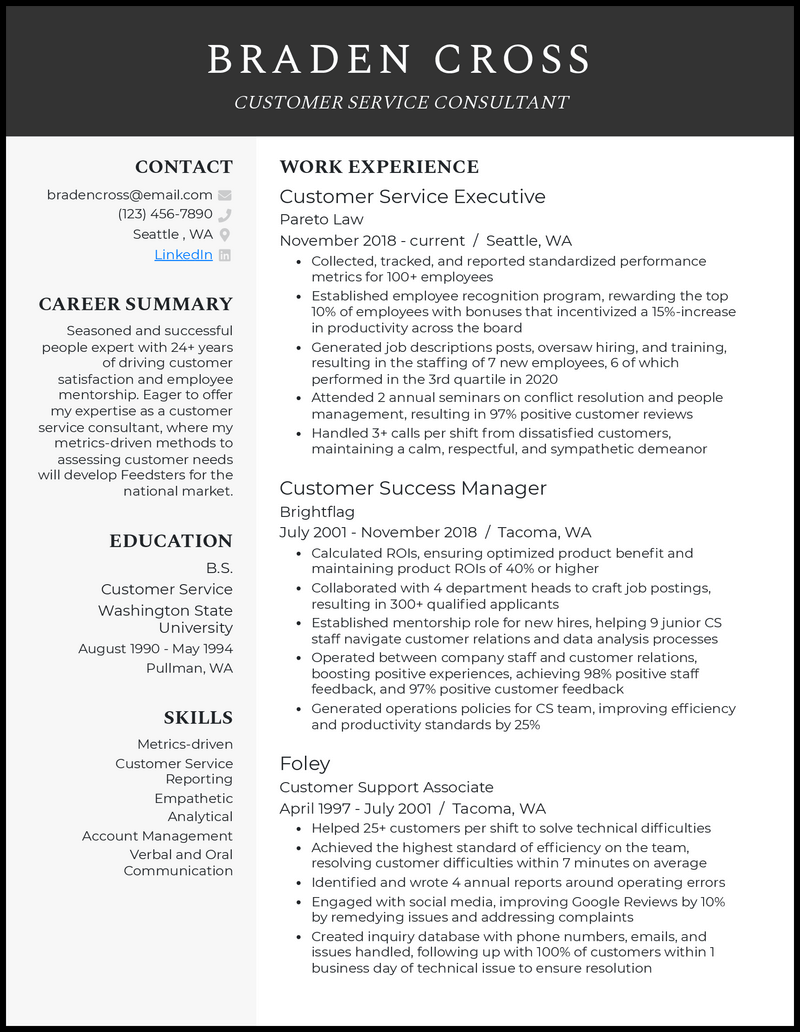
- Having trouble breaking up with the roles you had in high school? You can save old positions in a separate document, just in case. Just reassure yourself that you can discuss this expertise during an interview.
- Rather than cramming your work experience down to microscopic font size, try honing in on your most relevant work history.
- Since you probably have plenty of experience, you may want to consider including a resume summary , which can give a valuable overview of your skills and how they’ve driven results over the course of your lengthy (10+ years for a summary) career.
Customer Service Agent Resume
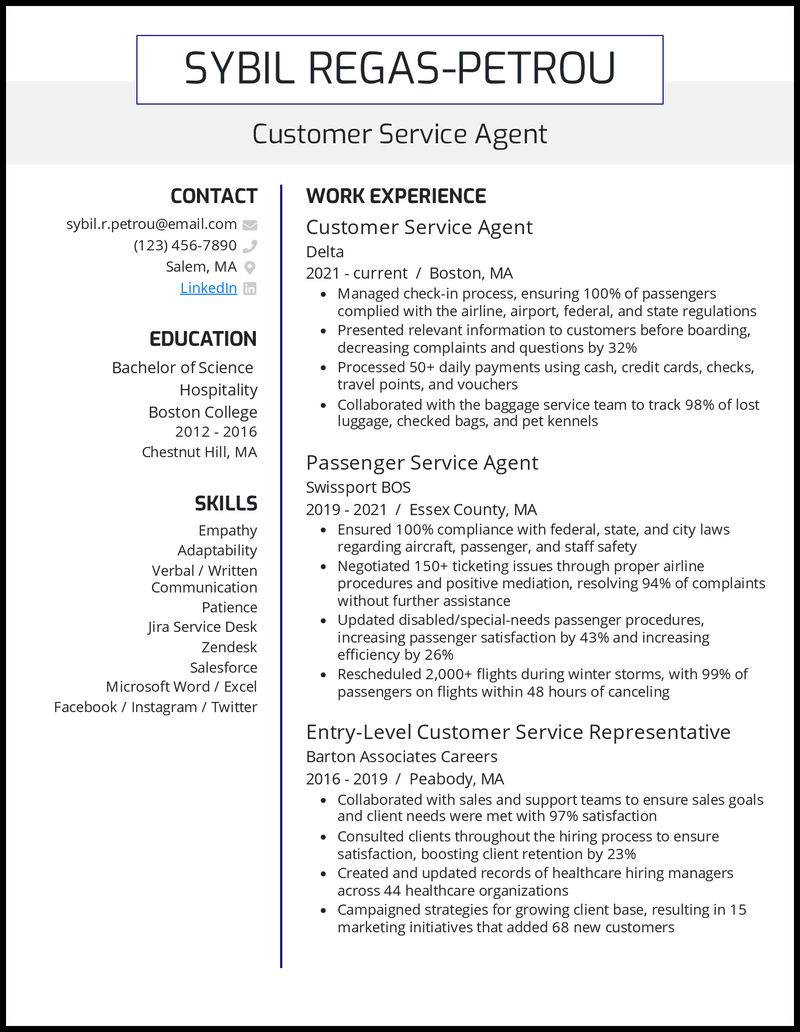
- As long as you’re not distracting from the content of your resume, go ahead and get a little creative.
- Do this by organizing your resume into distinct sections (subheadings are your friend), and use an unexpected pop of color to draw on your personality. Who said your resume has to be boring?
- Focus on adding hard skills, like Zendesk, Salesforce, and Microsoft Word.
Customer Service Success Specialist Resume
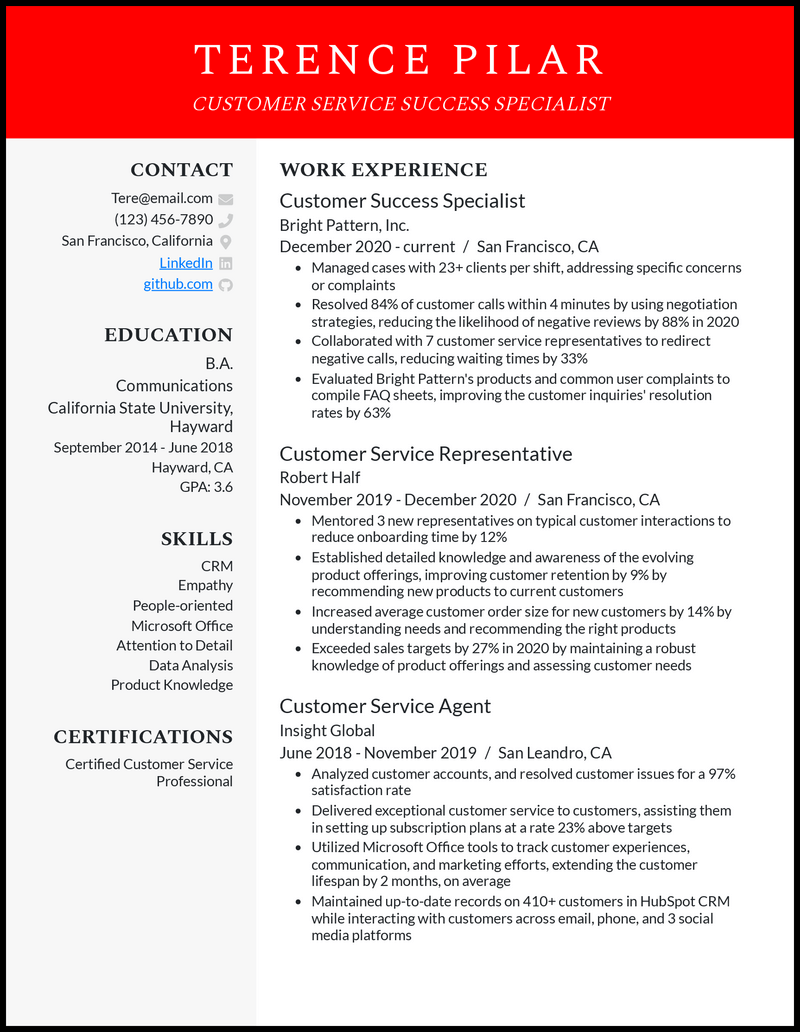
- Hiring managers in the customer service field often have less than a minute to review your resume, so it’s important that you place the most relevant information where they’ll see it!
- Emphasize growth in your career by ordering your work experience in a reverse-chronological resume format , meaning that your most recent experience will be listed at the top of the page.
- Including numbers in your work experience bullet points shows the employer that you’re great at your job! Ultimately, they’re looking for specialists who can perform the job well, and numbers prove that you can.
Customer Service Coordinator Resume

- That’s right. Your resume doesn’t need to look computer-generated to command respect. In fact, using a sprinkle of color can demonstrate your confidence and individuality, making you an even more appealing candidate.
- A word of caution: While more companies are valuing the individuality and flair of applicants, there are times when toned-down colors (like deep navy, slate gray, or hunter green) may be more appropriate. This can be especially true if you’re applying to a larger corporate business. Determine what’s best by investigating the customer service job description’s work culture.
Customer Service Advisor Resume

- Now, that doesn’t mean you need to bring the entire color wheel to your resume. Instead, focus on grabbing recruiters’ attention by using one or two colors for your section titles. You can start from scratch to find a visually-appealing color, or use a resume template if you’re not artistically inclined.
- Take your resume personalization to the next step by adding a career summary section if you’re a total pro in the field with more than a decade of experience. Use this section for some humble bragging and tell hiring managers about your biggest accomplishments over the course of your career. Because if there’s any good time to brag, it’s on your resume, right?
Customer Service Technician Resume

- It’s surprisingly easy! Using hard numbers throughout your resume makes hiring managers slow down and read more carefully, plus using metrics supercharges your resume clout and indicates that you know your value (literally).
- Don’t be afraid to highlight your hobbies and interests on your resume .
- But, please, please ensure you can relate them to the job. If you’re including a super interesting hobby, a hiring manager is almost certainly going to ask you all about it. You better 1.) actually do that hobby, and 2.) be able to relate that hobby to relevant customer service tech job skills.
Customer Service Representative Resume
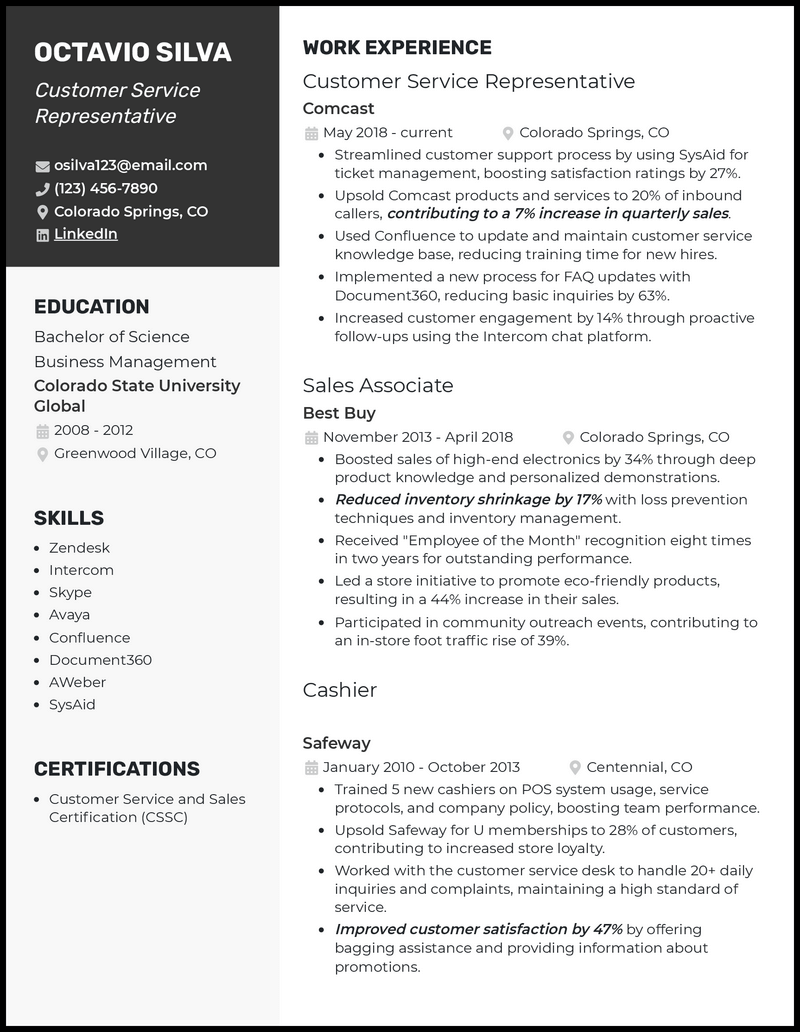
- So, instead of simply adding ‘Sales’ as a skill in your customer service representative resume , use an example of where and how you used said skillset. Try, “Boosted high-end electronic sales by 34% through deep product knowledge and personalized demonstrations.”
Call Center Customer Service Resume

- Format your resume so that your most recent experience and achievements are at the top of your call center customer service resume . By doing this, you’re presenting those highlights in a way that they’re the very first thing a recruiter will probably look at.
Professional Customer Service Resume

- Let’s say you have a Certified Customer Service Professional (CCSP) certification on your professional customer service resume—it immediately lets a potential employer know you’re well-equipped and ready to provide exceptional customer service.
Customer Service Supervisor Resume
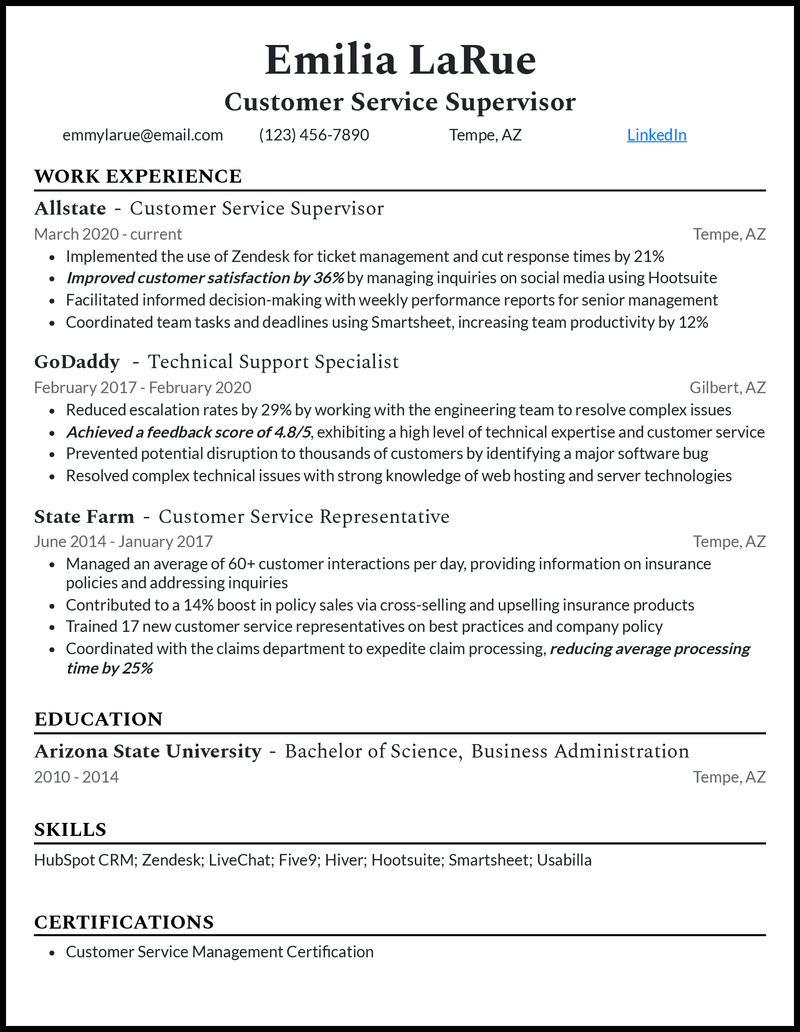
- If you know your way around a specific CRM or management software, don’t miss the opportunity to add it to your customer service supervisor resume and show an employer you’re a well-rounded candidate.
Remote Customer Service Resume
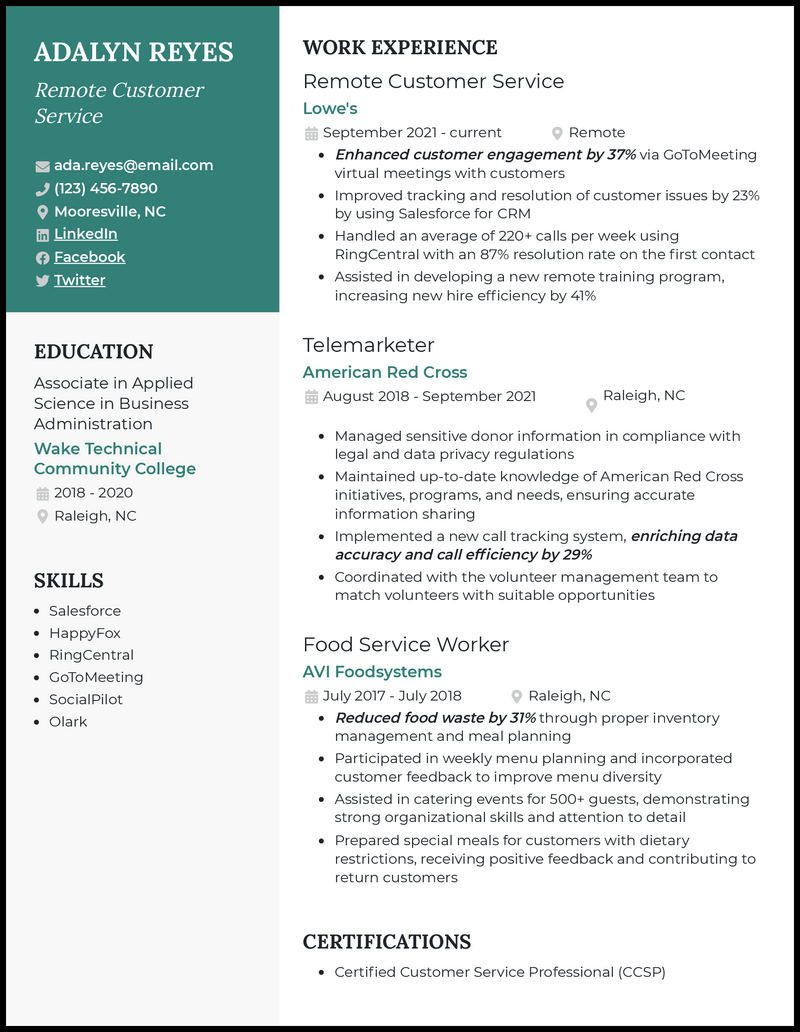
- By using a remote customer service resume template that’s clutter-free and spotlights what’s really important, you can show a recruiter what they need to see to form a positive opinion of you.
Customer Service Sales Resume

- Let’s take the poetry writing, portrait sketching, and vector illustration mentioned in this customer service sales resume . They convey that you have a knack for being creative, understanding design, and paying attention to detail—all of which will come in handy in your professional role.
Related resume guides
- Receptionist
- Sales Associate
- Front Desk Receptionist
4 Tips to Improve Your Customer Service Resume Today

Customer service resumes have gone beyond a simple list of experiences and education that prove your worth. Now, they’re as varied as the candidates themselves. Before writing a resignation letter and applying for your next job, check out BeamJobs’ list of recommendations to make your resume sound professional, look neat, and prove without a doubt that you’re the best candidate. We’ll cover:
- Customer service skills
- Formatting your customer service resume
- Quantifying your previous impact
- Customizing your resume for each job
Tip 1: Confidently choose your customer service skills
The skills section of a resume might be short, but it packs a punch. This is where you sell what you’re capable of and what you can do. This section is especially important for ATS to keep you in the running, so it’s crucial to pay attention to what skills you possess.
You should list both hard skills (like Microsoft Office Suite, HubSpot, or HelpDesk) and soft skills (like organization, problem-solving, and interpersonal communication). The best place to find applicable skills would be the job description itself—see what’s required for the tasks listed, and then use those tasks to steer you in the right direction.
Let’s say you run across a customer service job description requesting bilingual support like this:
- Answer telephone calls and emails promptly in Spanish and English
- Maintain and extend client base through positive customer interaction
- Excellent verbal and written skills in both Spanish and English
- Strong organizational and analytical skills
- Flexible—must be able to work independently AND with a team daily
Based on the job description, it’s clear this company values a bilingual, organized individual who is an effective communicator. These skills (as long as they accurately define you) should serve as the foundation of your skills section. And a word to the wise—don’t apply for a job if you can’t honestly say you own the skill set required.
Now, it’s time to tailor your skills section to the job description, which could look like this:
- Bilingual (Spanish and English)
- Organized
- Strong verbal and written communication
- Proven customer success
- Empathetic
- Methodical and thorough documentation
- CRM (HubSpot)
Not every customer service job description will look like the one above, so your skills section should reflect the role for which you’re applying.
The following skills would be great additions to other customer service positions:
- Data analysis
- Metrics-driven
- Customer service reporting
- Self-motivated
- Social media
- Creative problem-solver
- Inquisitive
Tip 2: Format your resume for the ATS and recruiters
When you open the pages of a book, what’s more inviting: dense blocks of text with little color or short paragraphs with headings, indents, and plenty of white space? The latter is easier to read and, thus, more inviting. Your customer service resume needs to follow the same principle since it’s your first impression. Make the recruiter’s job as easy as possible by being neat, easy to read, and understandable.
There are multiple ways to achieve this, but one of the easiest is to put things in reverse-chronological format . This helps recruiters know immediately where you’re coming from. (For example, if you recently worked as a customer service representative, you’ll have a shorter adjustment period. And even if you were a customer service rep a few years ago, the reverse-chronological order will help recruiters quickly assess your qualifications.)
Further suggestions for keeping your resume easy to read:
- Bullet points rely on keywords, essential for making your resume ATS-friendly. The condensed structure and repetitive points also relieve eye strain when reading.
- Place the customer service title beneath your name to make it easier for the recruiter to keep that specific job in mind as they scan your resume. This is especially crucial when a company is hiring for multiple positions.
- The average time a recruiter spends looking at a resume is six to seven seconds, which means you should only include necessities. Anything else that’s relevant can be brought up in the job interview.
- Some companies see them as antiquated, but others like knowing exactly what you’re aiming for. Scan resumes in the job field to see if others include them, and consider reaching out to current employees on LinkedIn for advice.
- Primarily, fancy icons or images may confuse the ATS. Beyond that, leaving them off your resume looks more professional; plus, it leaves room for more important things, like skills or awards.
Objective or summary for your customer service resume?
Objectives and summaries are a hot topic for resumes. It’s up to you to decide if an objective or summary is needed for your customer service resume. Typically, objectives/summaries are a good idea if you’re changing careers, you’re an entry-level applicant, or if you want to customize them for each application. Otherwise, it would be best to leave space for other things.
The difference between objectives and summaries rests in their purpose and your level of experience. Both are roughly two to three sentences, but an objective describes your interest and qualifications for the job while a summary highlights your past work . If you have limited experience, you should choose an objective to sell why you’re the best candidate, but if you’re years into customer service, you could include a summary to describe your unique background.
No matter if it’s a summary or an objective, it should always be concise, informative, and personal ; this is your chance to show your personality and skills before the interview, so make it count.
When you write your objective, communicate your reason for applying and why you’d make a great candidate. Avoid making it generic, flat, or too casual:
- College graduate looking for work in the customer service industry to start a life-long career. I’m hardworking, great with people, and skilled with computers.
Instead, your objective should be specific, detailed, and unique to both you and the job description. Try something that highlights your skills regardless of your experience level:

For those who have 10+ years of experience, a summary is the best way to go. Poor summaries have limited and vague information:
- I’m a manager who is seeking further professional growth. I’m good at resolving conflicts, handling money, and writing reports; looking for a job that will give me experience and career options.
Rather, a summary should be a highlight reel of your accomplishments and expertise. To further showcase your talent, add metrics here, too:

This summary is tailored to the position and outlines the candidate’s experience and skills while being personable and not too formal. By carefully crafting your objective or summary, you can rise above the competition in just two to three sentences.
Tip 3: Leverage metrics on your customer service resume
Leveraging metrics is all about avoiding generality and demonstrating success. Most job description bullets don’t describe how successful, friendly, or efficient you were. However, saying, “Assisted 200+ customers weekly with technical questions with a 98% customer satisfaction rate,” tells the recruiter the specifics of your talents and abilities.
Writing metrics for every single bullet point isn’t necessary, but including an estimate when you can is better than staying vague.
Some customer service metrics to add to your resume include:
- Customer satisfaction (CSAT) score: The core aspect of customer service is keeping customers happy, so providing high CSAT scores based on your interaction with customers is bound to get recruiters noticing.
- Net promoter score: Just like the CSAT, this gives an insight into how happy customers are with the company.
- Employee retention rate: This statistic works well if you’re in a management position with a tight-knit group. That means your leadership has a direct effect on how many customer service reps leave or stay.
- Resolution rate: By showing a percentage of solved cases, you demonstrate your effective problem-solving skills and care for the customer.
- Customer effort score: This shows how much effort it took to get an issue resolved. Less effort means you’re easier to work with and more effective, which is why a low CES score is useful to add to your resume.
- Customer/employee numbers: Providing the number of teammates, employees, or customers you’ve helped or served is a great way to show your capability in helping large volumes of people.
Now that you know what kind of metrics to include, below are some examples of how you can use them in practice. If you have trouble calculating some of the aforementioned metrics, HelpCrunch or Kustomer have some helpful formulas.
- Assisted over 250 patrons with technological questions monthly with a consistent 86 CSAT score based on interactions
- Extended the client base through positive, empathetic communication, resulting in a net promoter score of over 50
- Led a group of 20 employees through conflict resolution training, and updated onboarding processes that improved employee retention by 23%
Tip 4: Customize your customer service resume for the job
Just as every company is different, no customer service position is identical. So, why would you submit the same resume for multiple customer service job applications? Tailoring your resume shows you have researched the job and helps corroborate your candidacy.
Check the following list for advice on how to customize sections of your resume:
- Mention the company by name and what you hope to accomplish. Check the “job details” section of the job description to see what the company hopes to achieve, whether it’s boosting customer loyalty or increasing customer satisfaction.
- Many customer service jobs require similar skills, but that doesn’t mean your skills should stay stale. Check the job description’s qualifications to scan for skill keywords to use. Keep it under 10 to avoid being excessive.
- Include the job description requirements in your resume as much as you can. If the job description says they’re looking for someone who will “standardize quality customer service through positive customer interactions,” mimic that wording on your resume to describe your past achievements. This helps make your resume ATS-friendly while highlighting your skills.
- No matter the customer service role you’re seeking, there are many ways to write your resume so that it’s relevant and unique to every application:
Customer service resume
- All of these are good ways to customize your job description points.
- Include a concise objective that mentions the company by name, and highlight why you’re qualified for the job.
- Have you assisted large volumes of customers or boosted overall customer numbers? Have you increased efficiency or used specific software discussed in the job description?
Customer service rep resume
- Outcomes like increased sales or error reductions are great metrics to include.
- Highlight skills like empathy, friendliness, and negotiation in your skills section and job description bullets.
- Include your goals for your interactions with customers, like “established lasting relationships” to draw attention to your interpersonal skills.
Customer service manager resume
- Use verbs like “directed,” “led,” or “modeled” to demonstrate productive leadership.
- Include a summary to showcase the success of your career so far and what you can bring to your new job.
Entry-level customer service resume
- For example, if you were a lab assistant, you had to be highly organized and a great problem-solver, which would work well in a customer service resume.
- Stress your ability to work well with people—include any courses, extracurricular projects , or volunteer efforts where you interacted with people consistently.
Retail customer service resume
- Include past experience where you solved problems, troubleshot issues, or resolved disagreements.
- Anything relating to product management would be an excellent addition—think of past jobs that dealt with marketing or sales, especially if you can provide metrics like increased revenue or reaching sales targets.
Customer success manager resume
- CSMs must be able to see trouble coming and steer clear, so include responsibilities where you proactively and positively improved the customer’s experience.
- Resilience and tenacity are two core elements of the customer success journey, so long-term projects and goals are solid additions to prove you’re willing to spend the time to get something done right.
Bilingual customer support resume
- Include all languages in which you’re fluent in the skills section. Also, make sure to highlight your bilingual (or multilingual) abilities in your objective or summary.
- Mention how you improved your customer service strategies or practices as this will show you actively make customer experiences better for everyone.
Customer service consultant resume
- CSCs are also great advocates for both the customer and the company. They see things from both the customer’s perspective and the company’s, so keep your resume balanced between your advancements for the company and your success with customers.
The keys to your customer service resume
Resumes are your first impression, so it’s important you make a good one. By taking the extra time to customize and adjust your customer service resume, you’ll catch the eye of hiring managers. With your list of relevant skills, professional formatting, specific job metrics, and customized additions, your resume is sure to stand out from the competition.
Upload your resume to our resume checker to see if your resume meets our AI-powered recommendations. If you’re starting from scratch, use our resume builder , which allows you to create resumes from the ground up with helpful hints and tools from BeamJobs. If you’ve made it this far, it’s safe to say you’re well on your way to crushing your customer service resume!

Top 18 Customer Service Manager Resume Objective Examples
Updated July 12, 2023 15 min read
A resume objective for a customer service manager position is a short statement that appears at the top of your resume and explains why you are the best candidate for the job. It should be tailored to the specific role you are applying for and demonstrate your ability to meet the employer’s needs. When writing your resume objective, focus on demonstrating your customer service skills and experience, as well as any other relevant qualifications such as leadership or problem-solving abilities. For example, a resume objective might read: “Experienced customer service manager with 8+ years of experience in resolving customer complaints and implementing new policies. Seeking to leverage my expertise in providing excellent customer service and leading teams to fill the Customer Service Manager position at ABC Corporation.” Another example could be: “Dynamic individual with 10+ years of experience in managing customer service teams and driving sales growth. Looking to apply my knowledge of client relations, team building, and problem-solving strategies as a Customer Service Manager at XYZ Company.” By including specifics about your skillset and career goals, you can create an effective resume objective that will help you stand out from other applicants.

or download as PDF
Top 18 Customer Service Manager Resume Objective Samples
- To utilize my expertise in customer service management to provide excellent customer service and ensure customer satisfaction.
- To leverage my experience in developing and implementing effective customer service strategies to drive business growth.
- To bring my strong interpersonal skills and problem-solving abilities to an organization as a Customer Service Manager.
- To apply my knowledge of customer service processes and procedures to improve the overall customer experience.
- To use my leadership skills to motivate and inspire a team of customer service representatives.
- To lead by example, setting high standards for quality customer service while providing guidance and support to staff members.
- To build relationships with customers by providing prompt, courteous, and efficient service that exceeds their expectations.
- To develop strategies for improving customer retention rates through exceptional customer service experiences.
- Seeking a position as Customer Service Manager where I can utilize my experience in managing teams, resolving conflicts, and delivering excellent customer care.
- Aiming to secure a role as Customer Service Manager where I can put my strong organizational skills, communication abilities, and problem-solving aptitude to use.
- Looking for an opportunity as a Customer Service Manager where I can apply my expertise in developing innovative strategies for enhancing the overall customer experience.
- Seeking a position as Customer Service Manager with an organization that values excellence in providing outstanding client services.
- Aspiring to join an organization as a Customer Service Manager where I can contribute towards achieving organizational objectives through exceptional client services delivery.
- Desire the role of Customer Service Manager wherein I can use my strong interpersonal skills along with analytical capabilities to enhance the quality of services provided by the organization.
- Passionate about using my knowledge of CRM systems and process improvement techniques to increase efficiency within the department as well as improve overall customer satisfaction levels.
- Eagerly looking for a position as a Customer Service Manager wherein I can employ my extensive background in managing complex projects while ensuring high-quality results are achieved at all times.
- Aspiring for a challenging role of Customer Service Manager wherein I can apply my knowledge of industry trends & best practices while leading teams towards successful outcomes & enhanced performance levels..
- Looking forward to working with an organization as its Customer Service Manager where I can utilize my extensive experience in building relationships with customers & creating positive experiences that foster loyalty & repeat business opportunities
How to Write a Customer Service Manager Resume Objective
Writing a customer service manager resume objective is an essential step in creating a resume that will help you stand out from the competition. A well-written objective statement can be the difference between getting an interview and having your resume passed over. In this essay, we will discuss how to craft an effective customer service manager resume objective that will make you stand out.
The first step in writing a customer service manager resume objective is to identify your strengths and accomplishments. Think about what makes you unique as a customer service manager and what experiences or skills you possess that would make you a great fit for the role. Consider any awards or certifications related to customer service management, any relevant education or training, and any special skills or experience that may be of value to the company. Once you have identified these elements, use them to create a concise yet powerful summary of your qualifications for the position.
When writing your customer service manager resume objective, focus on emphasizing how your qualifications match up with what the employer is looking for in their ideal candidate. Use language that is specific and detailed while also keeping it concise and easy to read. Avoid using generic phrases such as “seeking employment in customer service”; instead, focus on how your particular skillset can benefit the organization. Additionally, keep in mind that many employers are looking for candidates who have demonstrated leadership abilities; if applicable, include examples of this within your objective statement as well.
Finally, end with a strong call to action that encourages employers to contact you directly or learn more about your qualifications by reviewing your full resume. This will help ensure they take notice of your application and remember why they should consider hiring you for their open position.
By following these steps when crafting your customer service manager resume objective, you can increase your chances of landing an interview with potential employers and ultimately securing the job of your dreams!
Related : What does a Customer Service Manager do?
Key Skills to Highlight in Your Customer Service Manager Resume Objective
As a customer service manager, your resume objective should clearly demonstrate your adeptness in managing customer service operations and leading teams to ensure customer satisfaction. Highlighting key skills in this section can significantly enhance the impact of your resume by showcasing your expertise and suitability for the role. This section will provide insights into the essential skills that you should emphasize in your customer service manager resume objective to make it more compelling and effective.
Empathy is a crucial skill for a Customer Service Manager as it allows them to understand and relate to the feelings and perspectives of their customers. This understanding can help in resolving customer complaints effectively, improving customer satisfaction, and building strong relationships. Including empathy in a resume objective demonstrates the candidate's ability to connect with customers on a personal level, which is vital in providing excellent customer service.
2. Adaptability
A Customer Service Manager often deals with various situations and people, each with unique needs and challenges. Adaptability is necessary to adjust strategies and approaches to effectively meet these varying demands. It also helps in embracing changes in the business environment, like new technologies or policies, ensuring smooth operations and customer satisfaction. Including adaptability in a resume objective can demonstrate a candidate's ability to thrive in dynamic environments, leading teams through change, and consistently delivering high-quality service.
3. Conflict Resolution
A Customer Service Manager often deals with dissatisfied customers, employee disagreements, or interdepartmental conflicts. Conflict resolution skills are necessary to handle these situations effectively and ensure a positive outcome for all parties involved. This skill demonstrates the ability to maintain a professional and harmonious environment which is crucial in customer service roles. It also shows potential employers that you can manage difficult situations and make decisions that benefit both the company and its customers.
4. Salesforce Proficiency
A Customer Service Manager with Salesforce proficiency is highly desirable because this skill allows them to effectively manage customer relationships and interactions. Salesforce is a leading customer relationship management (CRM) tool that helps businesses track and analyze their interactions with customers. This proficiency can lead to improved customer service, as it allows for better tracking of issues, more efficient communication, and the ability to anticipate customer needs based on past interactions. Moreover, it also aids in generating reports and insights that can help in strategic decision-making processes. Therefore, highlighting this skill in a resume objective can demonstrate a candidate's ability to leverage technology to enhance customer service operations.
5. Zendesk Expertise
A Customer Service Manager with Zendesk Expertise is highly valuable as this skill demonstrates proficiency in a leading customer service software. This expertise can help streamline customer service processes, improve response times, and enhance overall customer satisfaction. It shows that the candidate can effectively manage a team using this platform and utilize its features to track, prioritize and solve customer support tickets efficiently. This skill is crucial for a resume objective as it directly relates to the core responsibilities of the job role and can significantly contribute to the company's customer service success.
6. Time Management
A Customer Service Manager often has to handle multiple tasks and responsibilities at once, such as responding to customer inquiries, resolving complaints, overseeing staff, and implementing customer service strategies. Time management is crucial in ensuring that all these tasks are completed efficiently and effectively within the set deadlines. This skill also helps in prioritizing tasks, delegating appropriately, reducing stress, and improving productivity. Therefore, mentioning time management in a resume objective can demonstrate an applicant's ability to perform various duties simultaneously without compromising on quality or missing deadlines.
7. Active Listening
A Customer Service Manager needs the skill of active listening to effectively understand and address customer needs and concerns. This skill is crucial in a resume objective as it showcases the candidate's ability to engage with customers, empathize with their issues, and provide suitable solutions. It also highlights the potential for excellent communication within a team setting, fostering a positive work environment that prioritizes customer satisfaction.
8. Team Building
A Customer Service Manager needs the skill of team building because they are responsible for managing a team of customer service representatives. This involves not only hiring and training new team members, but also fostering a positive and collaborative work environment. Team building skills can help the manager to ensure that their team works well together, communicates effectively, and provides the best possible service to customers. This skill is crucial for a resume objective as it shows potential employers that the candidate can lead a team successfully and improve overall customer service performance.
9. Performance Analysis
A Customer Service Manager is responsible for overseeing the customer service department and ensuring the company delivers the highest level of customer service possible. Performance Analysis is a crucial skill for this role as it involves assessing and evaluating the performance of the customer service team. This can help identify areas that need improvement, develop strategies to enhance productivity and efficiency, and measure the success of implemented strategies. Including this skill in a resume objective shows potential employers that you are capable of monitoring and improving team performance to ensure customer satisfaction.
10. Multitasking
A Customer Service Manager often handles multiple responsibilities at once, such as addressing customer complaints, supervising staff, and developing customer service policies. Multitasking is a crucial skill for this role as it allows the manager to efficiently juggle these tasks without compromising on quality or productivity. Including this skill in a resume objective demonstrates an ability to handle a fast-paced work environment and manage various duties simultaneously, which can be appealing to potential employers.

In conclusion, the objective section of your Customer Service Manager resume is an essential platform to showcase your key skills. It's a brief yet powerful statement that can set you apart from other candidates. Highlighting your most relevant and impressive skills in this section can effectively grab the attention of hiring managers. Remember, it's not about listing all your skills, but rather emphasizing those that align with the job requirements and demonstrate your ability to excel in the role. Tailoring this section to each specific job application will increase your chances of landing an interview and ultimately securing the position.
Related : Customer Service Manager Skills: Definition and Examples
Common Mistakes When Writing a Customer Service Manager Resume Objective
A customer service manager resume objective is an important part of the resume, as it serves as a summary of the applicant’s skills and qualifications. Unfortunately, many applicants make mistakes when writing their objectives that can hurt their chances of getting an interview. In this essay, we will discuss some of the most common mistakes to avoid when crafting a customer service manager resume objective.
One mistake often made is being too vague or generic in the objective. An effective objective should be tailored to the job you are applying for and should highlight your unique qualifications for that position. For example, instead of simply stating “seeking a customer service management position”, state something more specific such as “seeking a customer service management position where I can utilize my five years of experience in providing excellent customer service and managing teams”. This will give employers an idea of what you have to offer and why you are qualified for the job.
Another common mistake is failing to research the company prior to writing your objective. It is important to take time to research the company’s products and services before crafting your objective so that you can tailor it appropriately. For instance, if you are applying for a customer service manager role at an online retail store, mention how your experience managing online customers would make you an ideal candidate for that particular role.
Finally, many applicants make the mistake of not including measurable results in their objectives. Employers want to see tangible evidence that you have achieved success in past roles so be sure to include any awards or accomplishments related to customer service or team management in your objective statement. This will help demonstrate your expertise in those areas and show employers why they should hire you as their next customer service manager.
Overall, a well-crafted customer service manager resume objective can go a long way in helping applicants secure interviews with potential employers. By avoiding these common mistakes when writing an objective statement, applicants can ensure that their resumes stand out from other candidates and increase their chances of landing an interview for the desired role.
Related : Customer Service Manager Resume Examples

A right resume objective for a Customer Service Manager should highlight the applicant's ability to deliver excellent customer service and foster positive working relationships, whereas a wrong resume objective would focus on the applicant's own goals, such as gaining career advancement.
Editorial staff
Brenna Goyette
Brenna is a certified professional resume writer, career expert, and the content manager of the ResumeCat team. She has a background in corporate recruiting and human resources and has been writing resumes for over 10 years. Brenna has experience in recruiting for tech, finance, and marketing roles and has a passion for helping people find their dream jobs. She creates expert resources to help job seekers write the best resumes and cover letters, land the job, and succeed in the workplace.
Similar articles
- Top 18 Customer Service Resume Objective Examples
- Top 18 Customer Service Advisor Resume Objective Examples
- Top 18 Customer Service Associate Resume Objective Examples
- Top 18 Customer Service Representative Resume Objective Examples
- Top 18 Customer Service Supervisor Resume Objective Examples
- Top 18 Director of Customer Service Resume Objective Examples

IMAGES
VIDEO
COMMENTS
A good customer service objective should be no more than two or three sentences. This way, the employer can quickly and easily see how you're qualified for the job. How to write a customer service resume objective. You can create your resume objective for a customer service position by following these steps: 1. First, consider your qualifications
A customer service resume objective is a component of resumes that briefly describes the skills, experience and abilities you can bring to a position. The resume objective belongs at the top of the resume and should be the first item below your name and contact information. This position ensures that it is the first section of your resume a ...
This can lead to increased customer satisfaction and loyalty, which are key objectives in any customer service role. Including problem-solving skills in a resume objective shows potential employers that the candidate is capable of managing difficult situations and ensuring positive outcomes. 5. Zendesk proficiency.
Follow these best practices when writing your customer service resume objective: 1. Focus on the employer's needs. Demonstrate how your skills will benefit the company and add value. Show how you can help improve customer experience and satisfaction. 2. Include relevant skills and experience.
11 good customer service resume objective examples. The following objective samples for various customer service positions can help you write your resume introduction. 1. Call center rep. Customer service professional with 4+ years' experience in hospitality and call-center settings. Skilled at dealing with multiple calls daily while solving ...
Career Change Customer Service Resume Objective. Motivated receptionist seeking a customer service position at Clover Services. Seeking to improve customer experience using a positive attitude, patience, and problem-solving skills. Received a 100% customer satisfaction score for three consecutive months in 2021.
Highlight relevant skills and experience: Your customer service resume objective should showcase your relevant skills and experience as a customer service representative. This may include your ability to communicate effectively and resolve issues of difficult customers. Use specific examples of how you have demonstrated these skills in the past.
6 Steps to writing the objective. These are the steps to follow in crafting a customer service objective that utilizes those ingredients. Understand the job requirements. Scrutinize the job description to determine the specific hiring expectations. Note keywords or phrases that appear more than once.
3 Tips for Writing a Customer Service Resume Objective. If you want to write a stand out customer service resume objective, here are three tips you can use right now: 1. Embrace Brevity. When it comes to objective statements, short and sweet is the way to go. Try to limit yourself to a few sentences at most.
Objective. Seeking a challenging role in a customer-centric company. With over 5 years of experience in the customer service domain, expert at resolving complex issues and maintaining a 97% satisfaction rate. Proven ability to build relationships and improve customer retention rates by 40% across multiple organizations. Work Experience.
Including adaptability in a resume objective can demonstrate to potential employers that the candidate is capable of thriving in a dynamic work environment and delivering excellent customer service consistently. 4. Problem-solving. A Customer Service Representative often encounters various challenges and issues raised by customers.
Examples of a low-value customer service resume objective. "Customer service rep seeking employment with a large company with room to grow.". "Recent graduate looking for work in a fast-paced team environment.". "I am a friendly, hard-working, people person with five years of experience in customer support.
Customer Service Resume Objective Examples - Bullet Format. Example 1. Self-motivated and resourceful customer service representative with proven competency in: resolving a wide range of product and service issues speedily and satisfactorily. exceeding customer's post-sales needs with energetic follow-up.
5. Zendesk proficiency. Zendesk proficiency is needed for a resume objective for a Customer Service Professional because it demonstrates the candidate's ability to manage customer interactions effectively. Zendesk is a widely used customer service software and support ticketing system.
Here are some elements you might include in a customer service resume objective: Specific Position: You're applying for a customer service position, so state it. Skills: Highlight customer-oriented skills like communication, problem-solving, or conflict resolution. Experience: Mention relevant experience only if it strengthens your objective.
Now, here are some good examples to help you write an irresistible objective for a resume seeking a customer service job: Top 25 Customer Service Resume Objective Samples . To obtain a Customer Service position with Anthem, Inc. to leverage strong ability to analyze problems in order to provide solutions; operate a PC/image station to obtain ...
Use our customer service resume examples as a reference when writing your own resume to land more interviews. Also make sure to pair your resume with a well-written customer service representative cover letter to maximize your chances of landing a job. April 15, 2024. Entry Level Customer Service Professional. 4.7.
This can lead to more effective problem-solving, improved customer satisfaction, and ultimately, better business outcomes. Including adaptability in a resume objective showcases one's ability to thrive in a dynamic work environment and meet diverse customer needs. 4. Zendesk Proficiency.
First sentence: Self-introduction where you mention your years of relevant experience (if any) and degree or level of education. Second sentence: Your most job-relevant hard and soft skills. Third sentence: The role you're targeting and how you plan to help the company achieve its goals.
Why this resume works. Embellish your customer service manager resume with a thoughtfully-written career objective.. Don't worry though! You can easily tailor it by mentioning the specific job title you're seeking, the company's name, and any position-specific skills you've learned.If these kinds of details paralyze you, take a breath; now, start off your resume-building adventure with ...
51 Examples of General Resume Objective Statements. An objective statement is a useful section on your resume that showcases your skills, experience and career goals. Hiring managers can review this statement to better understand your professional history. If you're creating a resume, reviewing examples of career objectives may be useful for you.
Including adaptability in a resume objective can help potential employers see that the candidate is flexible and capable of handling any challenges that may arise in the role. 4. Problem-solving. A customer service assistant often encounters various issues and challenges in their daily interactions with customers.
Expert Hint: If you've finished at least some college, like many cashiers in the US, you can also include a list of relevant courses you took. They are a great way to present you have gained some cashier skills. 4. Craft an Impressive List of Cashier Skills. For a great list of cashier skills, begin by identifying the ones relevant to the specific job and company.
For example, a resume objective might read: "Experienced customer service manager with 8+ years of experience in resolving customer complaints and implementing new policies. Seeking to leverage my expertise in providing excellent customer service and leading teams to fill the Customer Service Manager position at ABC Corporation.".